
The Ultimate Guide to Luggage Sizes: What Size Should You Get?
We use affiliate links, and receive a small commission if you make purchases through them. Find out more here .
Did you know that choosing a suitcase (or multiple cases, for that matter) in the right size can save you some money in luggage fees and help you become a more organized traveler?
On one end, unused space in your luggage will result in wrinkled clothes and a messy suitcase. Not to mention the extra weight and possible luggage fees. And on the other – having too little space will limit your packing capacity. That’s why nailing the correct luggage size is very, very important.
In this guide, we’ll tell you everything you need to know about all the different luggage sizes, restrictions, and more, so you can understand what size luggage is better for you. Make sure to check out our FAQ section at the bottom if you still have any questions!
Luggage Size Chart
But before we begin this article, down below you can check out our infographic and table with the most common luggage sizes, which will offer an easier way to grasp the differences between them.
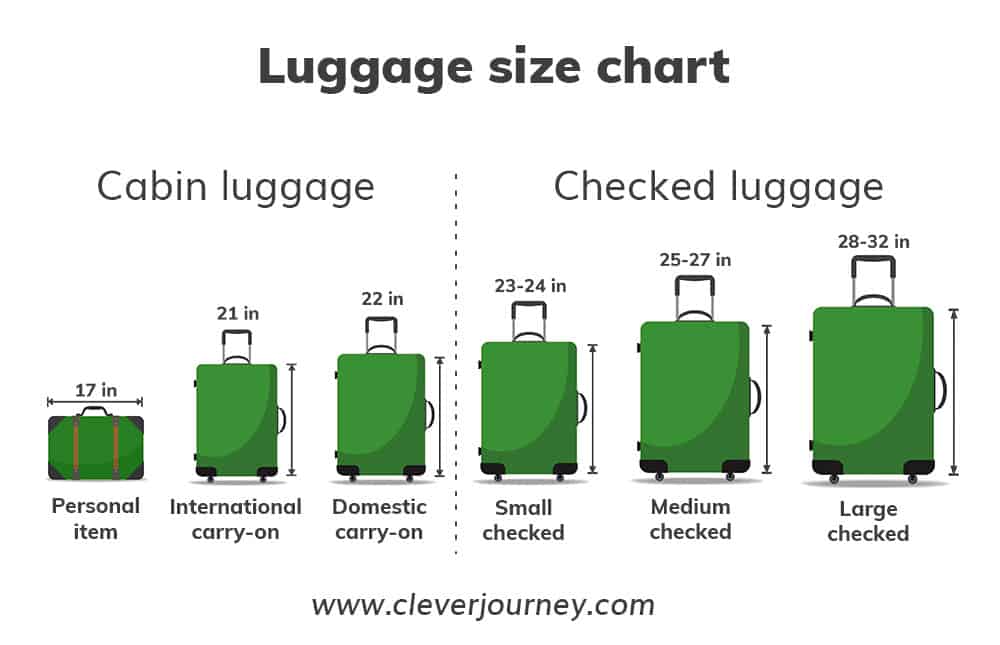
Measuring Luggage
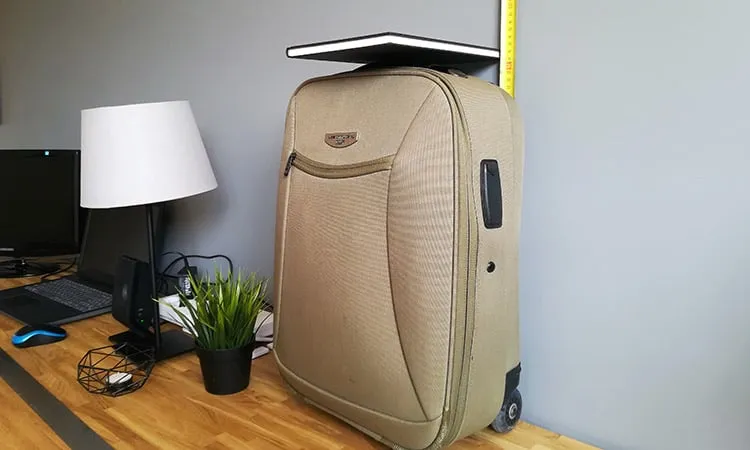
Basically, each airline has different size and weight restrictions for hand and checked luggage. Usually, premium airlines will allow slightly larger bags, and cheaper ones will allow smaller ones with tighter weight limits. Your job as the passenger is to find out the restrictions yourself because they change all the time, and it would be impossible for us to list and update each airline individually.
There are two types of size restrictions that you need to know. The first one is dimensions – height (top to bottom), width (side to side), and depth (front to back). It will usually be applied for personal items and carry-ons and could be stated as follows: 55 x 35 x 25 cm (22 x 14 x 9 inches). Airlines will usually offer measuring boxes inside airports, where you can put in your bags to check if they fit.
The second measurement is linear inches. Linear inches just means the total sum of height, width, and depth, and it’s mainly used for checked luggage, which needs to be under 62 linear inches. So to get linear inches, measure the height, width and depth individually and add them all up.
To measure the dimensions of your suitcase, you can place it next to a wall and measure the height, width, and depth by placing a measuring tape next to the wall. To get a more exact measurement, you can place a book or something flat on the other end of the measuring tape. Make sure to include the wheels, handles, and anything else that’s sticking out! Another thing to keep in mind is that fabric suitcases might become a bit larger once they’re packed to the brim, so before measuring, pack your suitcase full and measure in the widest end.
Hand Luggage
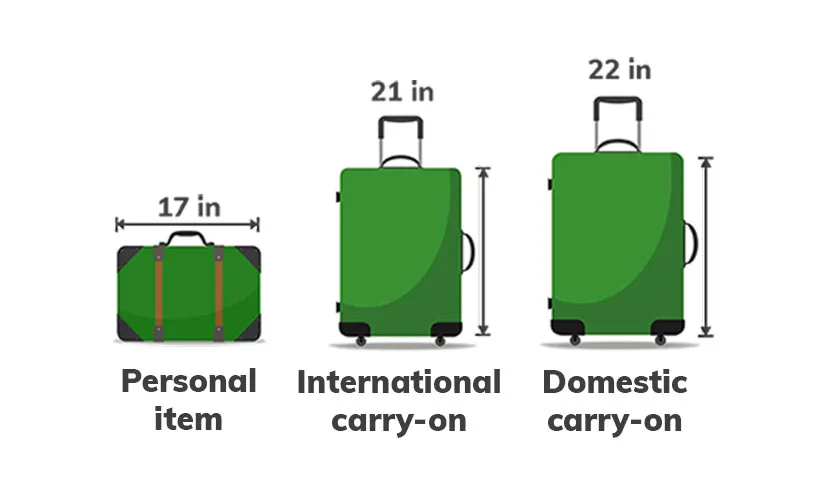
Hand luggage means all the bags that you’re allowed to take with you on the plane without checking them in. Usually, it’s a carry-on, a personal item, and any other items that aren’t counted towards the allowance, such as duty-free items .
Hand luggage has to be stored under each passenger’s front seat or in the overhead compartments, which are located above each seat. You won’t be able to access it during take-off and landing because they have to be tucked away securely in case of an emergency.
When you arrive at the airport, you won’t need to go to the check-in desks if you have just hand luggage, and you’ve already printed your tickets back home. You’ll be able to go straight to security , where TSA (Transport Security Agency) will screen your hand luggage for any prohibited items. After that, you’re free to do duty-free shopping or wait at the designated gate until boarding starts.
Carry-on Luggage vs Personal Items
The main difference between carry-on luggage and personal items (other called “underseat luggage”) is that carry-ons need to be stored in the slightly-larger overhead compartments and personal items under each passenger’s front seat. Usually, most people choose smaller rolling suitcases as their carry-ons and backpacks, duffels, or tote bags as their personal items. That said, you can use any type of bag as a carry-on or a personal item, whether it’s a briefcase, rolling suitcase, duffel bag , backpack, tote, or even a regular shopping bag.
You won’t really be able to access stuff from your carry-on during the first and last 15-30 minutes of the flight, as well as any turbulence, so pack your most necessary items in your personal item, such as your laptop , headphones, e-reader , any medicine, e.t.c.
Personal Item Size and Weight Requirements
Most airlines won’t specifically mention an exact size requirement for personal items, and instead, they’ll just say that it has to fit under the front seat. On average though, it should be 6-9 inches in width, 10-14 inches in height, and 17-18.5 inches in length . They avoid stating the exact measurements because each airline has different types of aircraft in their fleet and each aircraft has a different amount of space under each seat. To get the exact personal item size requirements, you should probably ask the airline directly, or check our list where we compiled personal item restrictions for most popular airlines .
Some airlines also have individual weight restrictions for personal items. But most of them just have some kind of weight limit for the total weight of your personal item and carry-on.
Tip: Looking to purchase a personal item? Check out the Matein Travel laptop backpack , which I’ve used as my personal item on multiple flights without any issues. It always fits under the front seat and it’s surprisingly spacious.
Carry-on Size and Weight Requirements
On average, carry-ons usually have to be 8-10 inches in width, 13-15 inches in height, and 19-23 inches in length. Each airline has different carry-on size requirements, however, the most popular one is 22 x 14 x 9 inches . The restrictions are so different between airlines because the overhead compartments tend to differ in capacity across different aircraft.
In terms of weight, each airline has different weight requirements for carry-on luggage. Most airlines in America don’t have any weight requirements for hand luggage but some do, especially budget airlines. If the airline has a carry-on weight limit, it’s usually between 15-35 lbs (7-16 kg) . Some airlines will also have a specific weight limit for the total weight of carry-ons and personal items.
Tip: Looking for a new carry-on? I’ve used the Travelpro Maxlite 5 19-inch fabric carry-on for a while now and I love it. It’s spacious, lightweight, and very durable. Even though it’s slightly over the limit in width, I’ve never had any issues with that on international flights.
Domestic Carry-Ons vs International Carry-Ons
When you’ll be shopping for a new carry-on, you’ll notice that some of them will be marked as “international carry-on” and some as “domestic carry-on.” That’s because carry-on size restrictions are usually stricter for international flights and looser for domestic ones. If you’re flying domestically, you might get away with a 23-inch (longest side) carry-on, but on an international flight, you’ll probably be limited to 19-21 inches.
So essentially, domestic carry-ons will be slightly larger than international ones. If the carry-on is too large , you will be asked to check it in, and you’ll have to pay additional fees. That’s why it’s important to buy a smaller carry-on if you’re planning on flying internationally. Usually, international carry-ons will have to be under 22 x 14 x 9 inches .
Hand Luggage Fees
Almost all airlines will allow bringing one personal item completely for free. When it comes to carry-ons though, most airlines allow bringing one for free, but budget airlines might charge a fixed fee depending on your class, which could be anywhere from 10$ to 50$. For instance, Spirit airlines will charge 31-50$ for carry-on luggage and Ryanair will charge about 6-20 EUR.
Keep in mind that most of these items are usually allowed for free in addition to other hand baggage:
- Assistive devices for the disabled
- Other wearable clothes
- Walking canes
- Food in disposable containers meant to consume on the airplane
- Child restraint seats
- Duty-free items
- Reading materials
- Cameras ( some airlines consider cameras as personal items, while others don’t. )
- Pet carriers ( Some airlines consider pet carriers as personal items, while others don’t. )
Read Next : 12 Best Underseat Bags Without Wheels in 2022
Hand Luggage Advantages and Disadvantages
Using only hand luggage and avoiding checked luggage altogether is a technique used by many, me included because it offers many benefits:
- No need to wait in line at the check-in counter
- Most of the time, completely for free
- Less likely to be stolen or lost because it’s on you at all times
- Easier to carry around, especially if you use a backpack as a personal item together with a carry-on suitcase
- The best place for keeping valuables and fragile items
- You can access all of your items during the flight
- Less likely to break because it isn’t exposed to baggage handling
However, there are some drawbacks to using only hand luggage, such as:
- Less packing space
- Harder to manage for families because they usually need to bring more items
- It needs to be lugged around the airport after security instead of being handed over at the check-in desks
- Usually, has much stricter weight limits
Tips for Buying Hand Luggage
- If you’re flying on short flights, consider using only an underseat rolling suitcase or backpack. People who fly for business often only need to fly out domestically for a quick meeting, so a lot of them travel with only a personal item. You can easily fit a spare shirt in there as well as some toiletries and a laptop, which is really all you need.
- For up to two-week vacations, a carry-on and a personal item offer more than enough space. Personally, I’m a light packer, and I can travel for up to three weeks or even a month using only a carry-on and a personal item. For most people, this offers enough space.
- Consider getting a backpack with a back strap as your choice of personal item. That way, you can secure it around the retractable handle on top of your carry-on, which makes it incredibly easy to lug around. Especially in crowded areas, such as public transport and airports.
- If you’ll be flying internationally, get a carry-on under 22 x 14 x 9 inches with wheels and handles included. On domestic flights, you’ll probably be able to use something larger, but if you want to avoid paying extra fees down the line, make sure your carry-on is under this limit.
- Make sure to get lightweight hand luggage. The weight restrictions are pretty strict as it is already, so make sure to get a lightweight carry-on and personal item. Especially the carry-on, because you’ll have to stow it in the overhead compartments. So instead of going with a hardside carry-on, get a fabric one instead, which will most likely be lighter.
Read Next: Airport Travel Terminology 101 – The Ultimate Guide
Checked Luggage
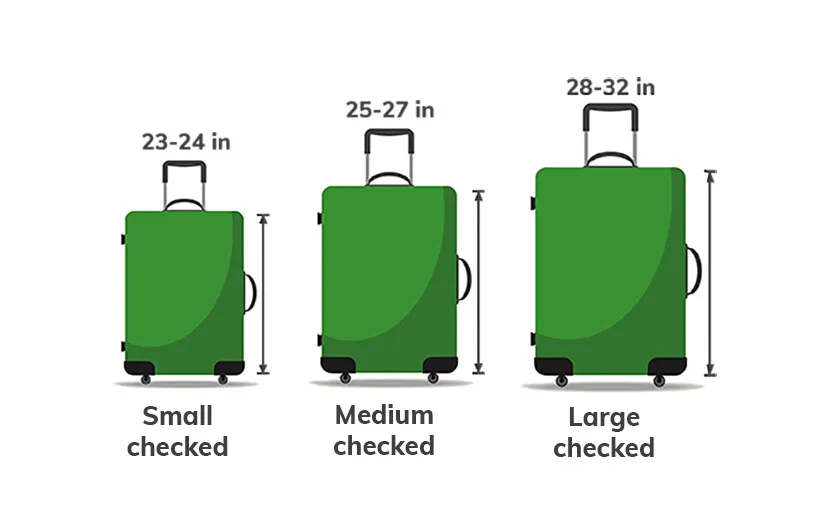
Checked luggage is all baggage that’s too large or too heavy to be carried on the flight, and has to be checked in instead. This means that you’ll need to hand it over at the check-in counters at the airport. The baggage will then be transferred over to baggage handling and it will be loaded in the cargo hold of the airplane . When you land, you’ll have to pick up your checked luggage from the luggage conveyor belts in the baggage reclaim area.
You can use other kinds of baggage as well for checked luggage, not just suitcases. You can also use large backpacks, duffel bags, totes, musical instruments in their cases, large trunks, and other oversized items. A lot of times, you’ll have to check in specialty items, such as large musical instruments and all kinds of sporting equipment, such as bicycles, snowboards, golf clubs, e.t.c.
Read Next: What to Put in Carry-on and What in Checked Luggage (Guide)
Checked Luggage Size and Weight Restrictions
Most commonly, checked luggage will have a size restriction of 62 linear inches (height + width + length) and a weight limit of 50 or 70 lbs. These are the IATA guidelines that are enforced in the EU and US which are there to keep the baggage handlers from handling too heavy bags. Oversized and overweight baggage will be accepted, but it will be labeled as oversized/overweight and you’ll have to pay a fee for that unless it’s sporting equipment. For instance, American Airlines will accept oversized bags up to 126 linear inches (320 cm) and overweight bags up to 100 lbs (45 kg.)
Small vs Medium vs Large Checked Luggage
Checked luggage comes in different sizes, and usually, the longest dimension is 23-32 inches long. Depending on the longest side, checked luggage is usually divided into three sizes, which are small, medium, and large. Small checked suitcases usually are 23-24 inches on the longest size, medium ones 25-27 inches, and large ones in 28-32 inches. Quite often, suitcases above 30 inches will actually be oversized, because they’re over 62 linear inches with wheels and handles included.
For most people, a medium checked suitcase will be the best option, because it will be just within the checked luggage size limits and offer a large amount of space for all of their items.
Read Next: 8 Best 62-Inch Checked Suitcases in 2022
Checked Luggage Fees
On most international flights, airlines will allow you to bring one or two checked bags completely for free. On domestic flights, usually, they’ll offer either one free checked bag or none at all. This depends a lot on the airline though. Additional bags will cost on a per-bag basis, starting with cheaper rates and continuing with more expensive ones. For instance, for American Airlines on domestic flights, the first checked bag will cost 30$, the second 40$, and the third one 100$ .
If you aren’t flying alone and you’re carrying a lot of checked bags, it’s usually a better idea to split them evenly among all the passengers to save some money on the checked baggage fees. It also isn’t advisable to bring more than two checked bags because the fees start to get pretty costly after that.
The fees for overweight and oversized luggage can get very expensive, upwards of 100-200$ for each bag, so before you arrive at the airport, make sure that each bag is under the weight limit.
Checked Luggage Advantages and Disadvantages
Although there are a lot of disadvantages for flying with checked luggage, there are some advantages as well, such as:
- Checked bags offer much more space
- Better for families who carry a lot of items
- Checked bags don’t need to be carried around the airport after checking them in
- No need to worry about size and weight, as the restrictions are pretty hard to reach
- You should be able to get away with a slightly oversized checked bag because they’re rarely measured
However, there’s a reason why I don’t travel with checked luggage. In my opinion, it has more disadvantages, such as:
- With a personal item, carry-on, and a checked suitcase, it’s much more difficult to use public transport
- Checked luggage is mostly a paid service, especially with budget airlines
- There’s just too much space if you’re a light packer
- Checked bags can get damaged from baggage handling
- Items get lost or stolen much more frequently when packed in checked luggage
- You won’t be able to access the contents of checked luggage during the whole flight
- In case checked baggage gets lost, you’ll be left without a lot of items and your trip might be ruined
- You’ll have to wait in the check-in line at the airport
Tips for Buying Checked Luggage
- Avoid plastic checked suitcases. Hardside ABS, Polycarbonate, or Polypropylene suitcases can crack pretty easily. When they’re thrown in the baggage area under a pile of other suitcases, this can happen very easily. That’s why you should choose an aluminum checked suitcase or a fabric one, which will be much less likely to break.
- Before buying a checked suitcase, double-check that it’s below 62 linear inches. Oversized checked luggage fees can get pretty expensive, usually between 100-200$. To avoid this hefty fee make sure that your suitcase is below 62 linear inches (height + width + depth) with handles and wheels included. A very large amount of large checked suitcases, in fact, about 50-80% of them are oversized, so pay close attention to the dimensions.
- A medium checked suitcase (25-27 inches) is more than enough for most people. Usually, medium checked suitcases are 58-61 linear inches in size, which is just below the 62 linear inch size limit, so when you’re looking for a checked suitcase, get one in this size.
- Get a bright or patterned checked suitcase. Checked luggage gets lost much more frequently. So when you’re shopping for a new case, make sure to get one that’s colorful and easy to recognize . It will be much easier to spot on the baggage carousel and if it gets lost, the chances of finding it will be much better because you’ll be able to describe it better. If you already own a dark checked suitcase, get a colorful patterned luggage cover .
- Avoid checked luggage with spinner wheels. Rolling, inline (2 wheels) suitcases are better options for checked suitcases because they’re much less likely to break while the bag is checked in. Spinner wheels are much more likely to fall off because they’re extended out from the main shape of the suitcase. It’s actually one of the most common things that break on checked bags.
- Consider getting a pelican trunk instead of a typical checked suitcase. They’re basically indestructible and they’re one of the most popular choices for climbers, camera crews, and other people who need to bring a lot of expensive checked gear.
What Size Luggage Should You Get?
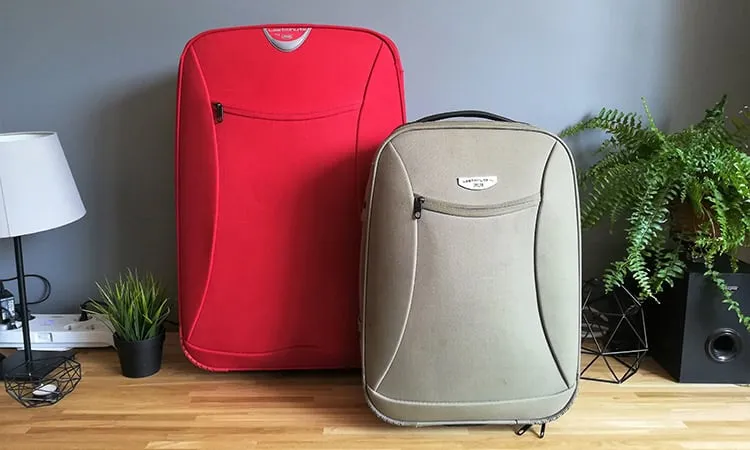
There are all kinds of different factors that determine what kind of suitcase you should get. Before buying any luggage, you should understand how often and where you’ll be traveling, how many people you’ll be flying with, what are your packing traditions, and so on.
Are You an Over-Packer?
There’s nothing wrong with being an over-packer, but it will affect what kind of luggage you should choose and how much you’ll be paying in fees. Most over-packers like to travel with a checked suitcase and a personal item, such as a small backpack, skipping the carry-on entirely. You’ll be able to pack your valuables and essentials in the personal item and be left with a very large amount of space in your checked suitcase, where you can pack all of your clothing and anything else you’d need. A medium checked suitcase will usually offer about 90-100 l of space while a carry-on only 35-50 l, so the difference is pretty significant.
How Long You’ll Be Traveling?
The length of your trips/vacations also determines what kind of luggage you should get. If you’ll be traveling for months, unless you’re an extreme minimalist, you’ll need to bring some kind of checked luggage. But for two to three-week trips, it’s perfectly fine to bring only a carry-on and a personal item, unless you’re an over-packer or you need to bring other kinds of gear for your job, planned activities, e.t.c.
Where You’re Flying to and What Are Your Planned Activities?
Think about what you’ll be doing and what gear you’ll need. Do you need scuba diving or skiing gear? Are you into photography and need to bring a large tripod? Are you flying to a cold-weather country and you need to bring a lot of extra warm clothing? The kind of travel that you’ll be doing, determines what size luggage you should get.
Think about valuable and fragile gear specifically. Try to keep the most valuable items in your hand luggage. If that isn’t possible, remember to ensure your gear and invest in a durable, large enough, checked suitcase or trunk. A good option for that is the pelican trunk , which is the industry standard for professionals.
Tip: It’s Better to Buy a Smaller Suitcase, Instead of a Larger One
Many people will probably disagree but I personally think that it’s always a smarter choice to buy a smaller suitcase instead of a larger one. This will make you become a lighter packer, which could end up saving you some money in the long run on checked baggage fees.
A lot of times, people are bringing gear that they don’t really need and end up with heavier, oversized suitcases. Remember that you’ll also have to carry your luggage around the town and to the airport. You’re on a vacation to get new experiences, not buy a lot of unneeded stuff, and be exhausted from carrying an oversized suitcase. Of course, if you’re traveling for work, that may not be true, but for general leisure travel, it’s a better idea to get a slightly smaller suitcase than you think you’d need.
What Size Luggage I Use Personally
I usually travel one or two weeks at a time, so a personal item (backpack) and an international carry-on are more than enough to fit in everything that I need. I rarely use checked luggage because I’m a minimalistic packer.
My favorite has become the B06XZTZ7GB ?tag=cleverjourn07-20&linkCode=ogi&th=1&psc=1′ title=’Matein laptop backpack’ target=’_blank’ rel=’nofollow noopener sponsored’ data-aawp-product-id=’ B06XZTZ7GB ‘ data-aawp-product-title=’Matein laptop backpack’>Matein laptop backpack for a personal item, which fits perfectly under the front seat and has many neat compartments for everything that I need. It’s 18 x 12 x 7.8 inches large, but I never pack it full, so it always fits under the front seat.
You Might Also Enjoy
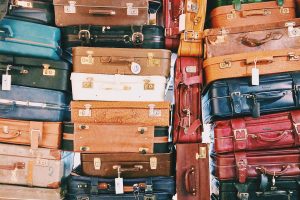
Leave a Reply Cancel reply
Your email address will not be published. Required fields are marked *
Save my name, email, and website in this browser for the next time I comment.
Featured in

GET CONNECTED
Follow Clever Journey on social media for travel tips, packing hacks, and latest updates!
SUB TO NEWSLETTER
Subscribe to our newsletter to get the latest travel tips, packing hacks, gear reviews, and bargain deals straight to your inbox. We hate spam, so we’ll send only the most important stuff.
Standard Luggage Sizes? – A Guide To Typical Suitcase Dimensions & Average Measurements
Last Updated on February 25, 2021
Did you ever stop to wonder why references to luggage sizes typically only give one dimension?
People talk about a “30-inch suitcase” or “25-inch luggage” but one measurement alone doesn’t tell us how big a suitcase is.
It reminds me how very young kids don’t realize that a tall thin glass doesn’t always have more juice than a short thick glass.
Jimmy is fooled because the tall container just looks bigger to him.
As adults, we know you can’t tell how much juice is in the glass from only the height.
But enough developmental psychology, the point is it’s the same with luggage sizes, to know the capacity of a suitcase you need to know the three dimensions, height, width, and depth.
These measurements are also crucial when it comes to airline size restrictions.
Don’t assume that if a manufacturer calls a suitcase a “checked bag” it is under the airline size limits for checked luggage . Travelers get hit with charges for oversize checked luggage all the time.
The same goes for the “carry on bag” label. It’s pretty meaningless since many bags labeled as carry-on size could land you with the cost of being forced to check it for being an inch too big .
So don’t trust the labels and also don’t assume that the bag with the bigger headline number will hold more clothes when packing.
Average Suitcase Sizes Chart By Type (Dimensions & Capacity)
Luggage manufacturers don’t always count the wheels and handle in their specifications. Airlines do count wheels and retracted handles! So this luggage size chart measures luggage dimensions from the bottom of the wheel to the top of the collapsed handle.
Personal Items & Under-seat Luggage
Personal Items are usually a purse, handbag, briefcase, or laptop bag that is taken on board in addition to a carry-on.
But since low-cost carriers like Spirit, Frontier, and United Basic Economy stopped allowing carry-on bags for free the personal item has become somewhere you might pack your clothes to save money.
Personal items need to be small enough to go under the seat. Check your airline to see what their size limits for personal items are.
A weekender bag often fits under the seat and as the name suggests these are good for 2 or 3 nights away.
But it’s possible to travel for extended vacations carrying only a personal item if you follow our traveling light tips . Basically, you need to pack quick-drying clothes and be prepared to do a bit of hand washing.
International Carry-On Size
If you are traveling internationally then the limit for your carry-on bag can vary tremendously. A good carry-on bag size for international travel is 21 x 14 x 8 inches. These measurements will be compliant with many airlines around the world. If you know the airlines you’ll be using you can check international carry-on luggage size limits before you travel.
Make sure you get a lightweight carry-on if you will be globetrotting. Airlines around the world often have restrictive weight limits for carry-on luggage.
Domestic Carry-On Size
The most common size limit for domestic carry-ons is 22 x 14 x 9 inches. Unless you fly exclusively on Southwest there is no good reason to buy a larger carry-on for travel within the US.
Carry-ons are great for business travel, short trips, or weekends away. Taking your luggage into the cabin saves time because you don’t need to wait at the baggage claim carousel.
It’s also easier to make sure your bag doesn’t get lost or valuables damaged if you keep your bag close in the cabin.
However cabin luggage introduces a little stress since space in the overhead bins is limited. Priority boarding helps with this since you get to the overhead lockers before the crowd.
Small Checked Bags
Small checked bags are basically over-sized carry-on bags. Often manufacturers “forget” to count the wheels or a protruding handle. This can mean that a strict airline will force you to check that bag.
Or perhaps you simply prefer the experience of checking luggage. It’s easier to board a flight if you are not worrying about getting your suitcase into the overhead bin.
Medium Checked Bags
The maximum size for checked luggage is often given as 62 linear inches. This means that height + width + depth must not exceed 62 when summed.
People often wonder how medium checked suitcases compare to the larger checked suitcases.
It seems like a reasonable question. How much space does a 25-inch suitcase have compared to a 32-inch suitcase?
But remember the story about the juice. One dimension doesn’t help us determine how big a case is. Taller isn’t always bigger.
The suitcase with the largest capacity for checked luggage would actually be a perfect cube 20.66 inches x 20.66 inches x 20.66 inches. That box would be under the 62 linear inches limit and have a capacity of 144 liters.
This very extra-large 32-inch checked luggage from IT Luggage is exactly 62 linear inches and has a capacity of only 90 liters. That’s a lot less than the perfect cube would be.

So the capacity of the bag doesn’t only depend on how tall it is. Width, depth, and how chunky the bag is matters a lot.
Large Checked Bags
Given the rectangular nature of most suitcases, 32 inches is about as high as they come. The largest checked bags will be in the 28-32 inch range.
A 28-inch suitcase can hold more than a 32-inch suitcase if the width and depth are greater.
Heck a 20-inch suitcase can hold more than a 32-inch suitcase, see the cube above.
With large checked bags in this range, you need to make sure that the sum of the three dimensions does not exceed 62 linear inches .
It’s also more likely that you will hit a weight limit. Penalties can be expensive if that happens so it’s always best to weigh your luggage .
22-inch, 25-inch, & 30-inch Luggage Bag Sizes Visually Compared
I get it. Online shopping is tough and sometimes you just want to eyeball it. Here are 4 common suitcases stood next to two people.
But if you really want to know how big the suitcase is your need to do the math.
Suitcase Size Calculator
Don’t worry, I did the calculations for you!
The model assumes 0.5 inch thickness of the suitcase. It also assumes you need 10 liters for things like your toiletries, your shoes, and laptop.
The remaining capacity is used to figure how many days worth of clothes you will fit into each size of bag depending on the season.
FAQ’s
A standard large suitcase size will be 30 – 32 inches in height. Sum the three dimensions and check they are under 62 to qualify as checked luggage.
Medium checked suitcases are around 25 – 26 inches.
The answer really depends on if you are willing to do laundry or not. If you have no intention of doing laundry and are traveling for many days you’ll need a large checked suitcase. If you are willing to wash clothes quick-drying fabrics can be washed quickly in the evening and will be dry in the morning. You can manage with a small carry-on even on long trips.
A carry-on suitcase can typically hold around 35 – 40 liters.
The size of a 25-inch suitcase depends what the other 2 dimensions are. Use the suitcase capacity calculator on this page to get the capacity in liters.
Multiply the three dimensions to get the size in cubic inches. Then convert cubic inches to liters.
A 28-inch suitcase is the same height as 4.5 dollar bills laid end to end. But you need to know all three dimensions to know how much clothes you’ll be able to pack.
A 62-inch suitcase would be massive, around the height of a teenager. A 62 LINEAR inch suitcase can be many different heights. The sum of the three dimensions needs to be be 62 inches. For example 32 x 20 x 10 inches.
There are 28.3 liters per cubic foot. A large suitcase will be at most 4 cubic feet.
Well… is it hot or cold where you are going? Do you need a different sweater for each day or can you wear the same one twice? Are you only packing clothes or do you need a laptop and 6 pairs of shoes? The size of suitcase you need for 10 days depends on the weight and volume of 1 days worth of clothes. Divide your suitcase capacity by how many liters you think 1 days worth of clothes is.
Will you be wearing shorts or jeans? Are you a size XXL or small? To determine the size of suitcase you will need try to figure what size a bundle of clothes for 1 day will be in liters. Could you imagine 1 days worth of clothes rolled into a 2 liter soda bottle? 14 days x 2 liters would mean you require 28 liters for clothes. Then add on your laptop, your toiletries, and your shoes to get the total capacity you require.
The Verdict
You can’t judge the size of a suitcase on only 1 dimension.
You need to multiply the three dimensions to get an idea of the luggage capacity.
Did This Page Help You?
People also ask.
- How do you measure luggage?
- What’s the largest luggage size you can check-in?
- What are linear inches?
- What are the dimensions of a quart-sized toiletries bag?
How Can We Fix The Page?
Please let us know how to improve the page we'll try to fix it.
There Were Errors On The Page It Was Missing The Information I Needed
Tell Us More...
Your Name (required)
Your Email (required)
Great! We Aim To Please!
Maybe you can help us.
Social shares allow us to continue to publish more articles so if you can help out by sharing it would be much appreciated!
Pack Hacker is reader-supported. When you buy through links on our site, we may earn an affiliate commission. Learn more
How To Choose the Right Sized Travel Bag for Any Trip
Finding a properly sized travel bag is a key part of any successful trip, from a simple weekender to a month-long adventure.
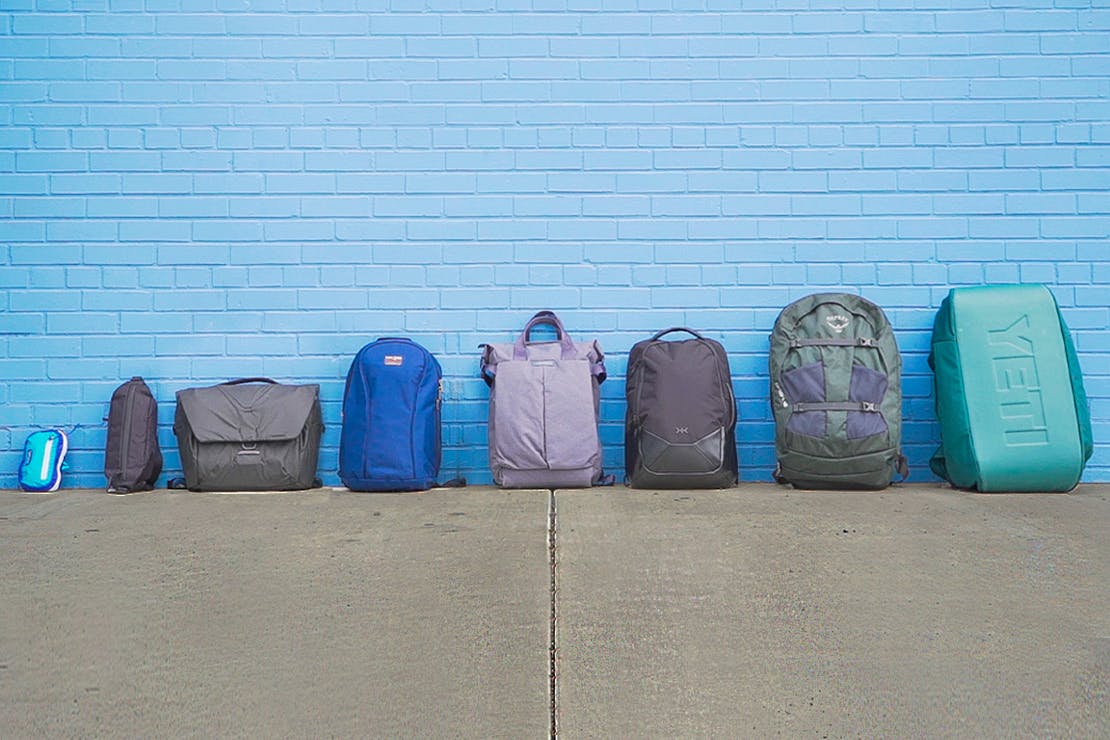
Getting Started
There’s a travel bag out there for everyone, and we’re here to help you find it. The process can be a little overwhelming, but narrowing down what needs to fit into your pack is a great place to start. In this post, we’re going to be talking about different bag sizes and their uses. By the time we’re done, you’ll know just what size pack you need (or at least be headed in the right direction).
We’ll cover everything from 1L slings that keep your pockets free all the way up to 60L outdoor adventure packs for carrying the whole shebang. Whether you’re searching for the perfect pack for daily commutes or are ready to jump off the deep end into backpacking across Asia, we’re psyched to help you get started.
Before we get into it, there are a few essential things to consider. When we mention liters, we mean it in terms of volume, not dimensions. Two different 40L travel bags may not fit the same amount of gear. This is highly dependent on the built-in organization, available compartments, and shapes that the pack implements. We notice the most significant differences between different brands, but sometimes even two travel backpacks made by the same company will differ in packability. Ensuring all your gear will fit inside is one of many critical pieces to the intricate puzzle of picking your next travel bag.
Here at Pack Hacker, we have a ton of travel gear reviews, guides, and how-to videos that will help get you started, continue your journey, or find your magnum opus.
Okay—now let’s get into the fun stuff.
Pocket Dump Sling (1L)
Starting off on the small end of the spectrum is the 1L sling, or what we like to call the Pocket Dump Sling. It might seem tiny, but we promise, 1L is bigger than you think! It’s small enough for you to wear it all day without getting uncomfortable, but it will fit just about anything you usually store in your pockets (hence the name).

Use it to carry your daily essentials: a cell phone, keys, wallet, headphones, and even a small point-and-shoot camera or snack. We also love using these packs while traveling to store a passport, earbuds, travel wallet, and other travel documents like a boarding pass. Pocket dump slings are great at the airport because instead of removing all the items from your pockets and slowing up the line, everything is already in the sling. Just throw it on the conveyor belt and continue through the checkpoint.
From this category, we recommend the Patagonia Ultralight Black Hole Hip Pack . It’s pretty versatile, as you can wear it as a sling or on your waist, and it packs away nicely for compact storage when not in use.
The Patagonia Ultralight Black Hole Hip Pack all packed up.
We’ve also found that a sling of this size is great for walks around a new town, city, or nature area while abroad. You can throw your essentials (and maybe a friend or partner’s essentials too, if you’re feeling generous), head out on the town, and keep your hands and pockets free the whole time.
Pockets Plus (2.5L)
If you love slings like we do but crave a little more space, try something around the 2.5L size. We call them Pockets Plus because they fit all the items we usually carry in our pockets, plus a few extra goodies.

This size is excellent for daily use and while traveling because it offers a little more flexibility in what you can bring along with you. Similar to a Pocket Dump Sling, you can leave your pockets empty when you head through a TSA checkpoint. You will also have additional space to bring entertainment like a Nintendo Switch or a small tablet, a couple of snacks, a battery bank, and a few cables to keep everything charged up while you’re on the move. We’ve even been able to fit a packable rain jacket and set of wet wipes, so long as they have a small enough form factor!
The Aer City Sling 2 all packed up.
We love the Aer City Sling 2 , which comes in right at 2.5L. It’s one of the more comfortable carries that we’ve tested, and it has ample space for stowing your gear. We also love its low-profile design, especially while traveling to ensure that we don’t look too touristy. While on the plane, have quick access to entertainment like a Nintendo Switch without digging around below the seat. You can even hook it onto the seat in front of you using a HeroClip for easier access. You’d better stow it during turbulence, though!
Messenger Bag (13L)
If you need to bring along more gear than a basic sling allows, we recommend you grab a messenger bag between 9L and 13L. These packs are great for when you don’t necessarily want the weight of a backpack, but your list of essential items is a little larger, like on short hikes or day trips to nearby towns abroad. If you are set on carrying a sling, there’s also a travel bag subset that's a cross between a messenger bag and a sling.
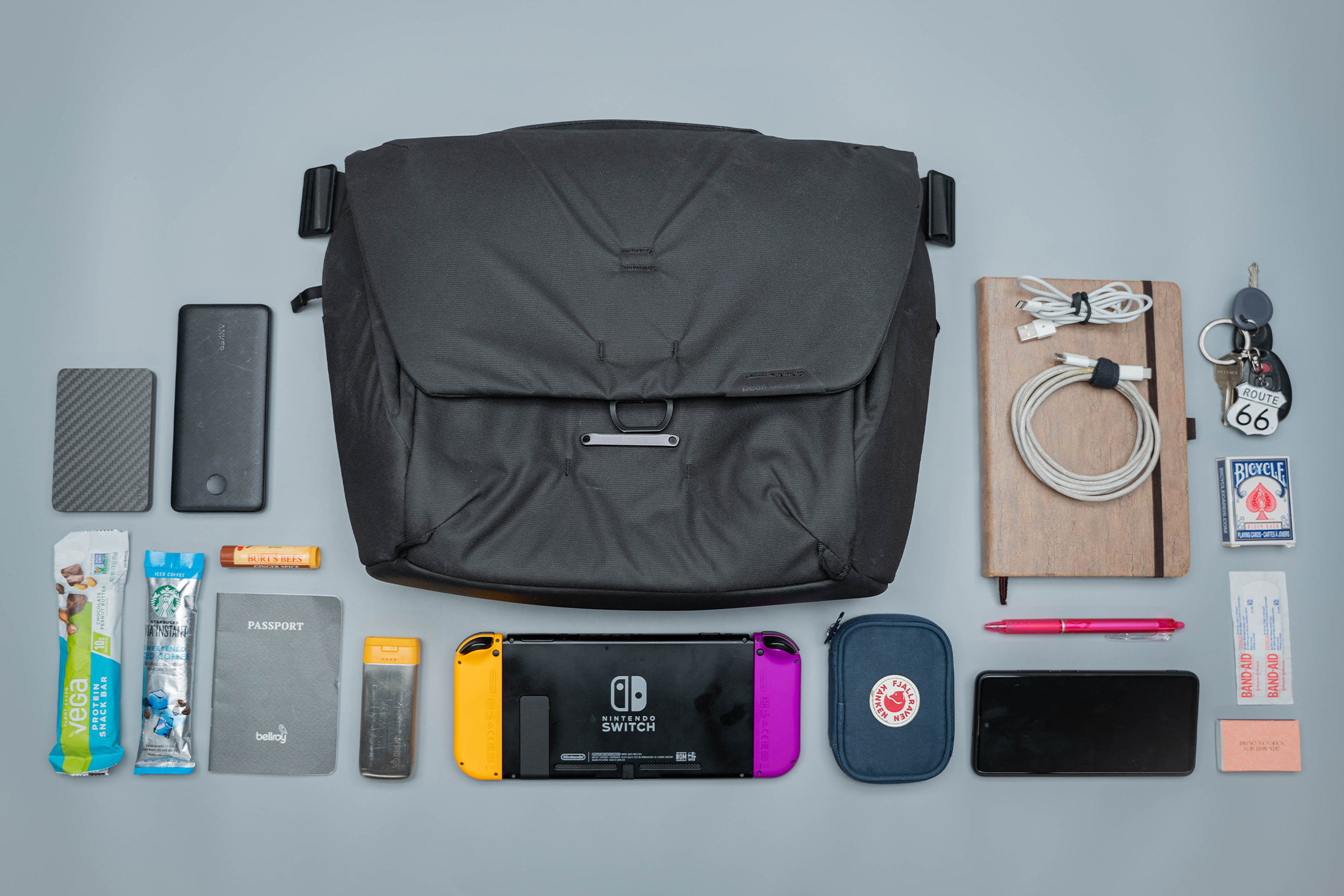
A 13L messenger bag is a good pick for commuters who want something that won’t take up much space on trains or buses. It’s also a low-profile option if you’re exploring a new city and need more space but don’t want a full travel backpack. These bags are also great for cycle commuting because they aren’t too heavy and allow access to your gear while in transit.
There are many different styles to go with, so it's essential to think about which features are important for your usage needs. A pack with a large main compartment will hold the most gear but lacks the organization that some crave. A pack with more organization may not have as much room for larger items, but each item has a home.
The Peak Design Everyday Messenger all packed up.
In the 13L range, we like the Peak Design Everyday Messenger pack, as it can fit all of our daily go-to gear inside the large main compartment. It does have some organizational capabilities with the included FlexFold dividers, but in our experience, the dividers aren’t the most durable. As we said, it all depends on your specific usage needs.
Daily Bag (15L)
Some people don’t like slings and would prefer to wear a backpack while commuting to work or exploring a new city, which is just fine by us. For a travel bag you can wear every day and carry most of your work essentials, we recommend something between 15L and 18L. This should give you enough space to bring all the gear you need, plus a little bit extra.
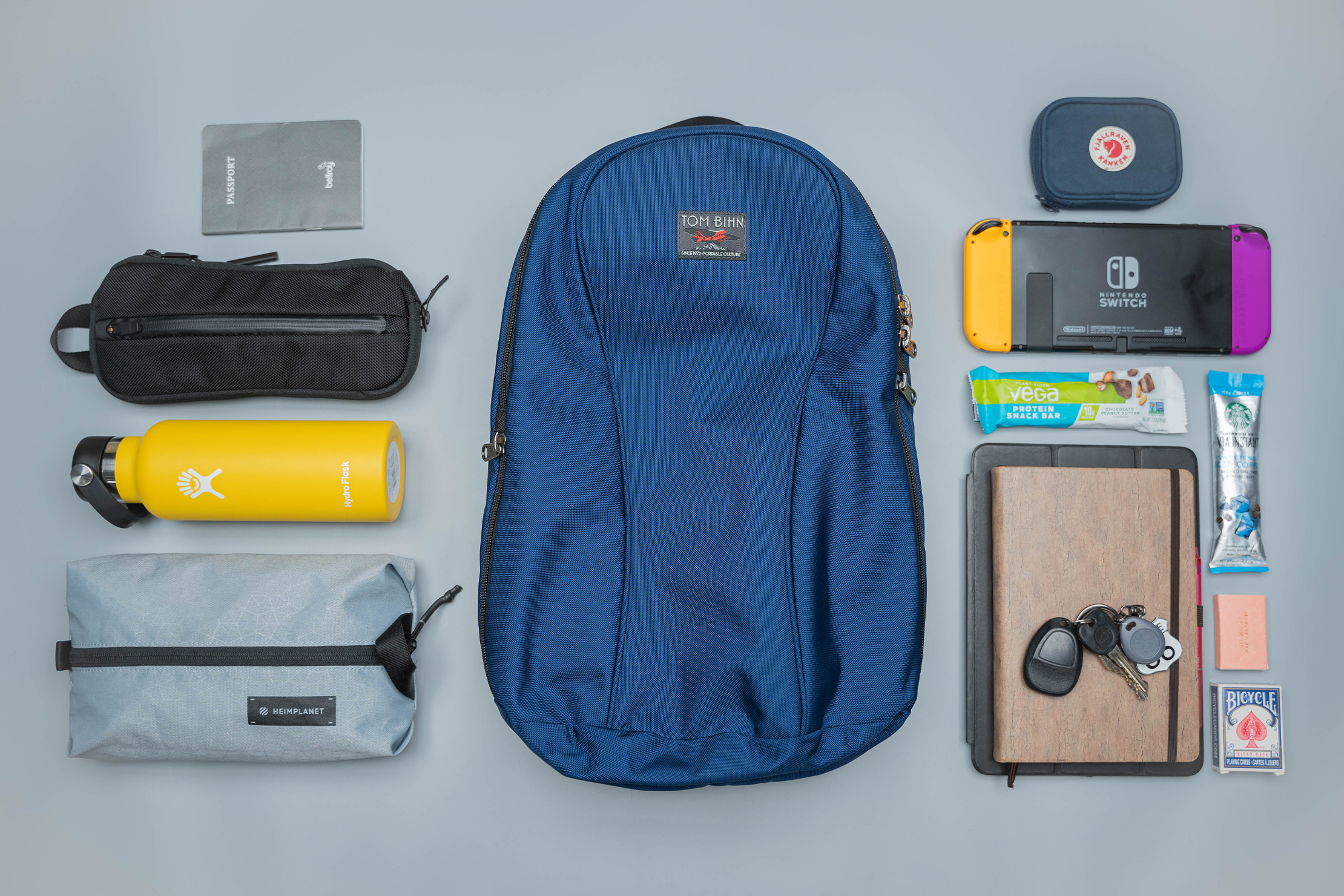
Although just a minor step-up from the 13L messenger, we’ve found that those two to five liters can make all the difference. Not only can a daily bag carry everything you need for work, but it will also be versatile enough for extracurriculars, too. So much room for activities!
Hit the gym after work, stop at the coffee shop for a drink and to get your side-hustle on, or even head out for a hike somewhere on the way home. The biggest draw of a daily bag over the smaller packs listed above is the ability to do an abundance of different activities without stopping home to drop off and grab more gear.
The Tom Bihn Luminary 15 all packed up.
We recommend the Tom Bihn Luminary 15 , Able Carry Thirteen Daybag , and Away Small Zip Backpack in this range. Each of these packs will be able to carry a laptop, water bottle, packable jacket, and even a few extra goodies like a tech pouch, phone, wallet, or change of clothes. They all keep a pretty low profile, so you won't feel like you're lugging around a giant travel bag.
Personal Item Backpack (20L)
Shifting from a daily bag to a personal item bag is another small jump, but we’ve found that a 20L travel backpack has just enough space for a weekend trip, or longer if you pack smart. We like this size travel bag because it will likely fit under the seat in front of you on a flight, which means no pesky carry-on fees or worrying about your bag getting lost, which is a big plus. They're great for heading straight to the airport from the office, as they can handle your work needs with your travel accessories added in, too.
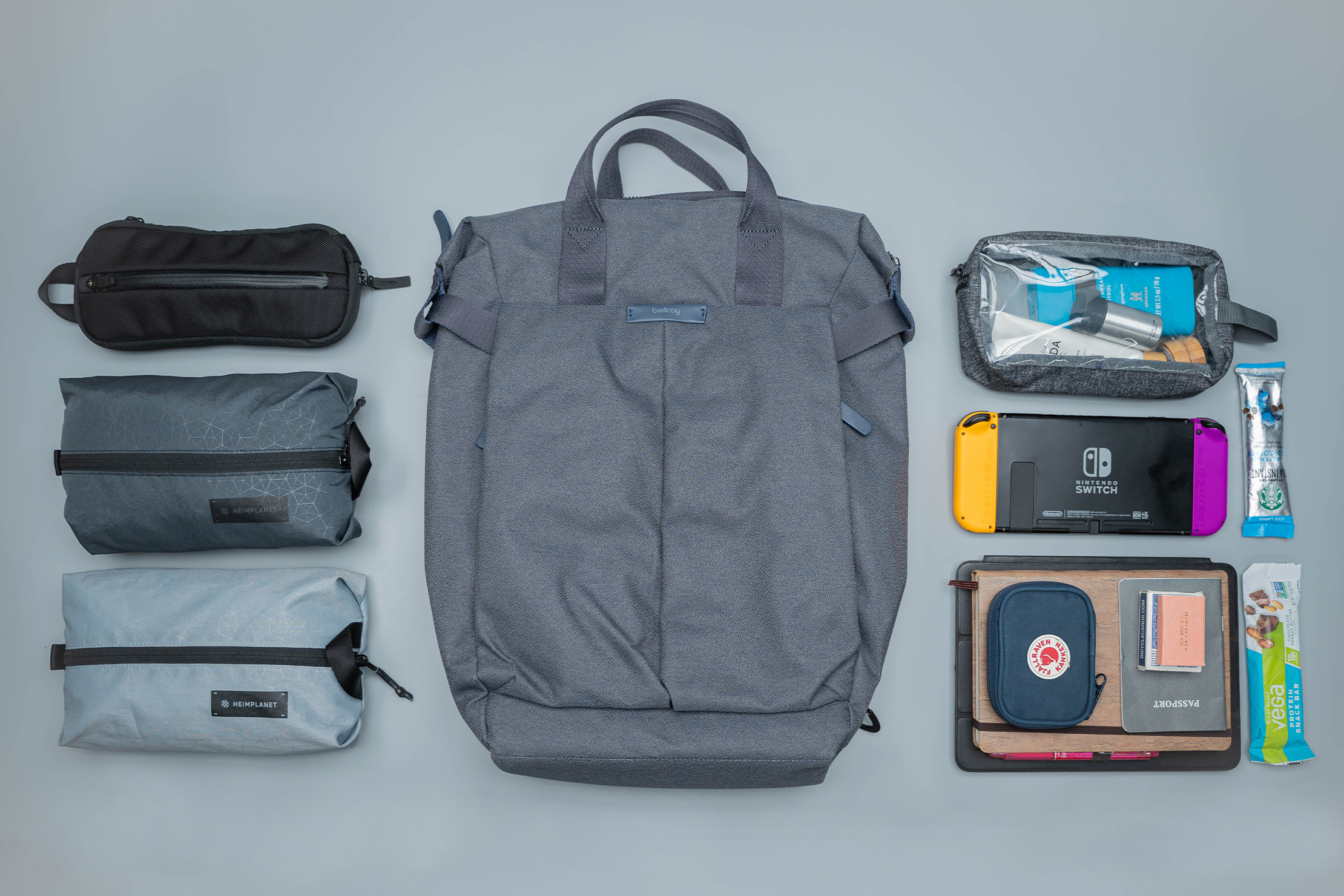
It's important to note that it's ultimately up to your airline to decide whether or not a travel bag is allowed to be used as a personal item, but we’ve found that most packs around 20L will fit the bill. It's always a good idea to check the specific rules and dimensions of who you'll be flying with before you start packing, though. There isn't much worse than getting to the airport to find out that your personal item has evolved into a carry-on and that you're stuck with the bill.
After you've stowed your laptop and other travel essentials, you should have room for a packing cube or two. This is great for organization and ensuring that you have all the items that you need for the duration of your trip. If you pack minimally and strategically, you can make a personal item backpack work for week-long trips, too!
The Bellroy Tokyo Totepack all packed up.
In this range, we recommend the Bellroy Tokyo Totepack . It has an open main compartment that is great for getting the most out of the volume. Toss in a few packing cubes and a tech pouch, and you're ready to take on the weekend!
Daypack/Travel Backpack Hybrid (30L)
We love the daypack and travel backpack combo because it enables you to pivot between everyday activities and traveling with ease. We like travel bags around 30L for this purpose because anything larger will be a bit too big for daily use, and anything smaller won't have enough gusto for longer trips. Finding that happy medium is vital for a comfortable journey without sacrificing any essential gear along the way.
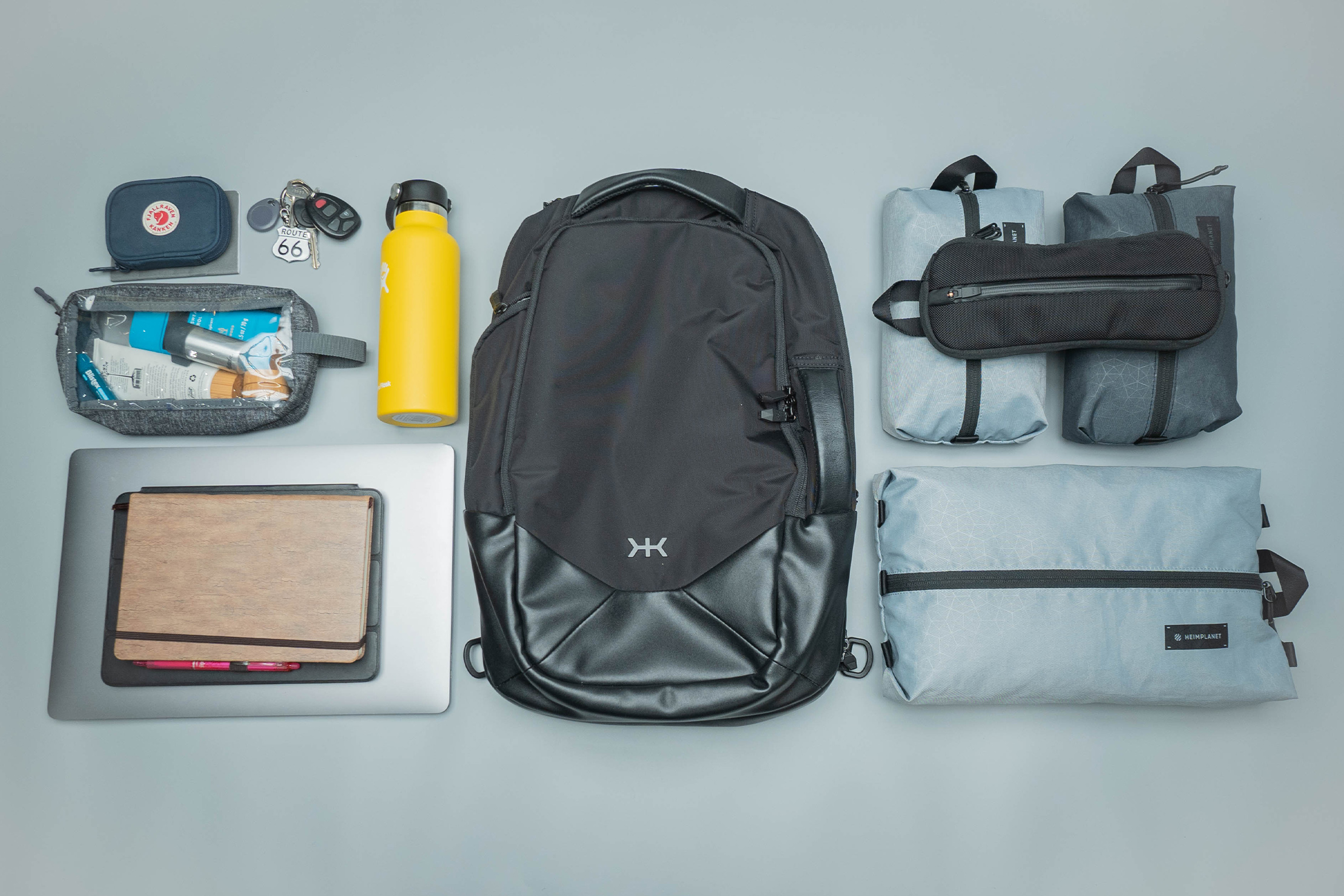
For us, a good daypack and travel backpack combo needs to fit a laptop, tablet, toiletry kit, several small or medium-sized packing cubes, a tech pouch, and other various odds and ends. However, your packing list may vary depending on how you like to travel.
We keep an eye out for ways to compress or expand a hybrid travel bag because this enables it to be more versatile. Compression straps and compression zippers are both great features that will allow you to adjust the size depending on your needs at the time, but not all brands include these options.
When you arrive at your destination, take out packing cubes and other items that don't need to be with you at all times. Then you can compress the pack (if it has that feature), fill it with what you need for the day, and head out into adventure mode. When it's time to head home, load the gear and cubes back up with any souvenirs you picked up along the way and go to the airport. If you've picked up too many presents for your family back home, a travel backpack with attachment points is great because you can clip additional pouches and accessories on the outside of the pack.
The Knack Pack Series 2 all packed up.
The Knack Pack Series 2 is a pack with a lot of features for more efficient travel. Uncompressed, the pack is 35L, a great size for traveling, but it sizes down to a handy 24L for daily usage. It has a ton of internal organization, ensuring that every item will have a home and nothing will get lost on the journey. Both of these features make it a great contender to get you to and from your destination stress-free, which means you will be able to enjoy your trip more.
Travel Backpack (40L to 45L)
We're now on the edge of what can be considered a carry-on bag, and we have to admit, we’re loving every minute of it. Most 40L packs are about as large as you’ll be able to bring onto the plane, but adding a few more liters is worth it if you can (and want to) check a travel bag.
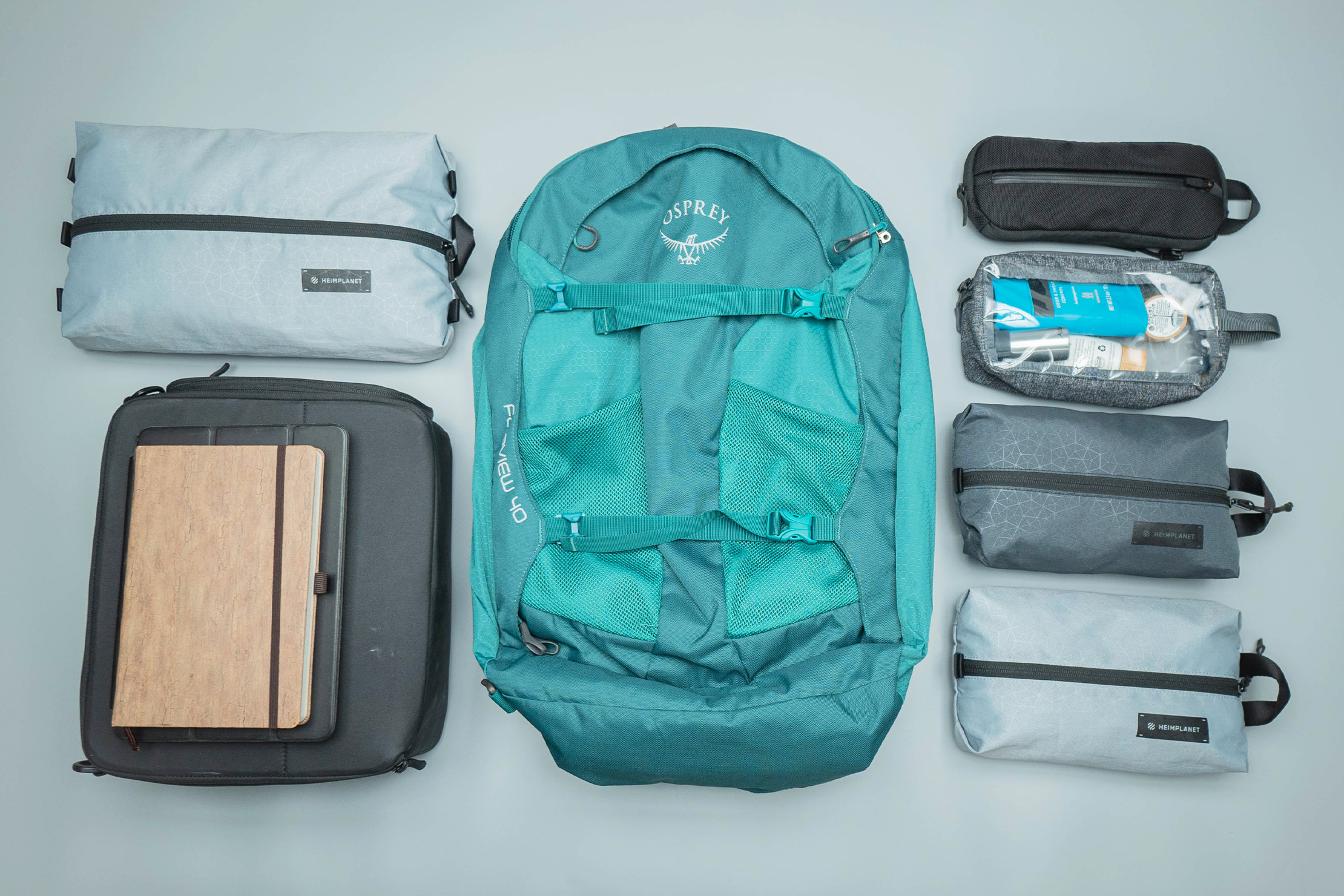
These packs are the standard size for one-bag travelers who will be away from home for extended periods of time. Suppose you will be spending a few months bouncing around different countries in Europe, a year exploring what Asia has to offer, or country hopping through Central and South America. In that case, this size travel bag has your name all over it!
Now that we’ve made our way to the larger end of the size spectrum, we tend to look for a few features that add quality of life. We like clamshell packs because they give you the ability to see the entire main compartment at once, rather than digging through to make sure you have everything you need for a day's work or specific adventure. It's almost like a suitcase you can wear on your back, and we find we can be most organized and comfortable this way.
The Osprey Fairview all packed up.
One of our favorites in this category is the Osprey Farpoint. The pack comes in both men’s ( Farpoint ) and women’s ( Fairview ) styling at 40L. Our team has tested this travel bag for over a year in over a dozen different countries worldwide and found that it can hold all of our gear and remain comfortable in almost every situation. No bag is perfect, but a quality travel backpack will quite literally be by your side through it all, so ensuring that you get all the features you need is essential.
Gear Hauler (60L)
Ah, finally. The granddaddy of them all.
Have you ever heard the phrase “everything but the kitchen sink” and thought, well, what if I want to bring the kitchen sink, too? Then you're in the right place. A gear hauler is a great fit for a road trip where the size of your travel bag isn't the biggest concern. This normally comes in the form of a duffel, but there are a couple of colossal travel backpacks out there if that's your preference.

In the 50 to 60 L range, gear haulers are also great for outdoor adventures and hobbies that require a lot of equipment, like camping. Another great use for such a pack is to transport coats, snow pants, boots, and skiing and snowboarding gear in the winter.
We’ve also run into on-the-move creators who find them useful when packing audio and video equipment alongside their clothes on trips where they won't be able to stop back at home between gigs. The great thing about a huge travel bag is that you don't need to worry about what you’re bringing because of the sheer volume these packs offer. Unless you quite literally bring your kitchen sink, odds are, it will fit.
The YETI Crossroads 60L all packed up.
In this range, we like the YETI Crossroads 60L Duffel . It has a monumentally large main compartment that's complete with two stowable dividers, which is great for separating different kinds of gear. You could do clothes in one, camera equipment in another, and food and snacks in the last one for an epic cross country photography road trip. Or you could fill all three sections with the Pokemon cards you've been collecting since you were a kid and stow it on the top shelf of your closet so your partner thinks you finally got rid of them after all these years. The opportunities are endless!
Wrapping Up
As you can probably tell, there are a ton of travel bags out there, and each one thrives in a different setting. Odds are, you’ll have a use for almost all of the packs we listed here, but it’s about figuring out what works best for you and your specific usage needs. Be sure to check out our gear reviews , guides , and blog for more assistance finding your perfect pack!
January 31, 2022

Author: Eric Hergenreder
Eric has been across the globe, but his favorite place to explore is his home state of Michigan. His love for photography has taken him all around the Great Lake State, often writing about his travels so that others can enjoy them, too. Eric loves messing around with analog photography, watching soccer, and searching for the world’s best burger in his spare time.


Luggage Size Guide [Size Chart and Recommendations]
Luggage is a great way to travel light and still have a lot of space. But it can be a challenge to choose the right size. The wrong size can make you feel like you’re carrying a ton of weight when you don’t need to. Besides, it can cause you to pay extra at the airport. So how do you know what size you need? This luggage size guide will help you figure out what size suitcase or backpack you should buy.
Standard Suitcase Sizes
Luggage size chart, american carry on luggage sizes, european carry on luggage sizes, asian carry on luggage sizes, middle eastern carry on luggage sizes, what size is carry-on luggage, personal item size and weight requirements, carry-on size and weight requirements, checked luggage size and weight restrictions, what size luggage do i use for my travel, final words.
The internal dimensions of the suitcase determine how many pounds or kilograms a bag can hold. The sizes are measured from the ground to the top of the carry handle, not from the inside. It’s typical for suitcase manufacturers to label sizes in inches and indicates that size with a prefix. To find the best carry on luggage for traveling, read this whole article.
So, let’s see some carry on sizes and their capacity, and then you can have some idea about them.
Well, if you don’t have any idea about the luggage size which one you should buy, then you can have a good and clear idea from the below images. This chart of the luggage size could be the best luggage size guide for you to buy a new one. By seeing the image you can easily differentiate and understand the capacity.

You can see the luggage size chart is divided into two categories namely Cabin Luggage and Checked Luggage. The Cabin Luggage includes Personal Item Luggage, International Carry-on, and Domestic Carry-on while the Checked Luggage is categorized into Small Checked, Medium Checked, and Large Checked luggage. We are going to mention the size and capacity of that luggage later.
As you have looked at the image very carefully, you might have some ideas about the capacity and the size of the luggage that you might need. However, we will now make a table and will try to show the inches, probable capacity, and fees if you are traveling by air.
Carry On Luggage Sizes by Airline
The most common Carry-on luggage size in the United States is 22 x 14 x 9 inches. Bear in mind, when your carry-on will be measured, the 22″ height limit includes the wheels and handles for suitcases.
However, most airlines limit the size of carry-on bags to approximately these dimensions while some airlines allow bigger bags and some are more restrictive.
You are highly recommended to confirm the sizing chart surfing the airline’s website before taking off, and then use the chart below to calculate the correct size for your travel.
In case, you’re traveling on multiple airlines, you need to be more careful about the luggage you are carrying.
Anyways, you’ll only find the most reputable airlines that enforce their weight and size limits.
However, if you’re planning to buy a new carry-on bag , check the airlines that you fly most often and buy one that will fit all of them. Now let’s see some different continents’ airlines’ carry-on luggage sizes.
Worldwide Carry on Luggage Sizes

There are many different sizes of carry-on luggage available and each airline will have its own specification for carry-on luggage. However, the standard domestic carry-on luggage size is 22″ x 14″ x 9″. It includes the handle and the wheels.
This size limit ensures your bag will fit easily in your overhead bin for your flight.
A typical size for carrying your own luggage is between 20″ and 25″ wide and 13″ and 17″ high. This may be slightly smaller or larger depending on the airline that you’re flying with.
A carry-on bag should ideally be about 30 inches wide by 22 inches tall and 45 pounds or less (in weight). If your bag doesn’t fit that description, consider using a smaller, carry-on-sized bag that you can take out of the overhead bin.
Carrying your own luggage is definitely the best option for travelers. You’ll be able to transport your belongings yourself, and you’ll have control over when you get to your destination, and how much they’ll cost when you arrive.
If you’re not a frequent traveler, it may take you a while to get used to the concept of checking luggage.

When traveling by air, try to pack as light as possible. Most airlines won’t give exact weight restrictions for personal items, so be sure to pack what you need.
Personal items must fit under the seat or in the overhead bin. If you don’t know what size to get, try the first option.
It should be 6-9 inches in width, 10-14 inches in height, and 17-18.5 inches in length on average.
You can get the exact personal item requirements from your airline, or check the list of personal item restrictions for the most popular airlines.
This is why, if you’re flying with an airline that allows you to carry a certain amount of personal items, it’s best to check if those items have weight restrictions.
Some airlines have personal item weight limitations, but not all of them do.
But most airlines have a maximum weight for the total weight of your personal item and carry-on luggage, so you should check to make sure that you’re not going to exceed that limit.

According to TSA guidelines, carry-on bags are limited to 8-10 inches in width, 13-15 inches in height, and 19-23 inches in length.
It depends on which airline you’re flying. But if you want to avoid getting checked in and having a hassle during security, the carry-on size for most airlines is 22 x 14 x 9 inches.
The regulations on airplanes are so different because the overhead bins on airplanes tend to vary in size and capacity.
Weight is a big factor in what kind of luggage you’ll need to check when you fly with an airline.
Most airlines in the USA don’t have any weight requirements for hand luggage. However, some carriers, especially budget airlines, may impose weight restrictions.
Some airlines will also have a specific weight limit for the total weight of carry-ons and personal items.
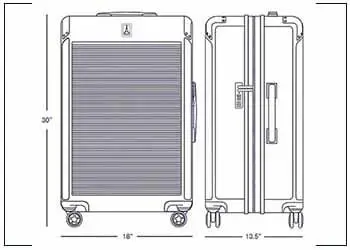
Most often, checked luggage will be limited to a height of 62 inches (measured from the top of the handle to the bottom of the wheel well). If your luggage weighs more than 50 or 70 pounds, it will have to be packed into a single piece of luggage and you can only bring one piece of carry-on baggage.
The maximum weight of a bag that baggage handlers are allowed to handle is the IATA guidelines, and they’re enforced by the airline, not the airport or the airlines. They’re the International Air Transport Association’s guidelines that are enforced in the EU and U.S. These guidelines were created in order to prevent people from handling too heavy of luggage.
However, if you carry oversized as well as overweight baggage, the airlines won’t refuse to carry it but it will be labeled as oversized/overweight and you’ll have to pay an extra fee for that unless it’s sporting equipment.
American Airlines accepts oversized bags up to 126 linear inches (320 cm) and overweight bags up to 100 lbs (45 kg.)
So, be careful about your luggage size. Oversized luggage can make you suffer.

My bags are usually very small. The only thing I’ll pack into my carry-on bag is an international flight kit (small backpack).
I only carry the things that I need for the trip. I don’t like checking bags because it means more things to carry.
For my personal item, I like the Matein laptop bag . It fits perfectly under the front seat and has lots of neat compartments for everything I need. It’s 18 x 12 x 7.8 inches, but I rarely pack it full, so it always fits under the front seat.
You can fit a Kindle Fire in this pocket-sized case. It’s not that hard to fit in the pocket if you take out some clothes.
For the carry-on, I use the TravelPro Maxlite 5 International 19-inch carry-on , which is pretty light and small enough for domestic luggage. It’s 21.75 x 15.75 x 7.75 inches large with wheels and handles included.
This is a large, strong, high-quality backpack that can be used as carry-on luggage, and if it doesn’t fit in the overhead
Measuring a shirt is always tricky. If you’re not careful, you can make it tighter than it was originally.
My laptop backpack comes with a retractable handle that allows it to be carried by its straps, and this makes it easier to carry in the overhead compartment of an airplane.
I’ve had a spinner wheel for a while, and it’s handy because my carry-on has spinner wheels, and they’re super easy to move around.
The biggest advantage of packing the backpack on top of the carry-on is that you can fit more stuff in a smaller space.
I recommend packing lightly. There’s no need for lots of extra stuff if you are like me.
If you’re planning to travel for more than one week, you should get a 25-27-inch checked suitcase instead of the carry-on.
Traveling can be a pain, but it doesn’t have to be. Whether you’re looking for a carry-on or a checked bag, there’s the right luggage size for you. That’s why the size of your luggage is a very important factor when it comes to choosing a suitcase for yourself. In fact, if you are looking for the best luggage for men or women, you should know that there are different sizes of luggage and that you have to choose the right one for you. Hope this luggage size guide was helpful to you.
Read More Articles –
- How To Protect Luggage From Theft
- Backpack Checked Luggage? [6 Pro Tips]
- Largest Luggage Size for Check-in [Latest Information for 2022]
- 9 Best Backpacks with Lots of Pockets [Buying Guide-2022]
- Uprights vs Backpacks – The Wise Pick
- How to Protect Luggage from Theft
- How to Clean Fabric Luggage
- Can You Wash a North Face Backpack
Leave a Comment Cancel reply
Save my name, email, and website in this browser for the next time I comment.
Use SAVE500 for an additional Rs.500 off*
Use SAVE1000 for additional Rs.1000 off*
Use SAFARI5 for Additional 5% Off
Exchange Offer Now Live on Backpacks

- Select Backpacks
- Select Business Trolley
- Select Satchel Bags
- Explore All
- Hard Trolley Bags
- Soft Trolley Bags
- Laptop Trolley Bags
- Printed Trolley Bags
- Trolley Bags for Men
- Trolley Bags for Women
- TSA Lock Trolley Bags
- Anti Theft Trolley Bags
- Black Trolley Bags
- Red Trolley Bags
- Purple Trolley Bags
- Blue Trolley Bags
- Gun Metal Trolley Bags
- Trolley Bags Set of 2
- Trolley Bags Set of 3
- Make Your Own Combo
- Cross Combos
- School Bags With Laptop Compartment New
- School Bags For 7 To 9 Year Olds New
- School Bags For 10 to 15 Year Olds New
- Aesthetic Bags For School New
- Genius Backpacks New
- 3 Compartment School Backpacks
- 4 Compartment School Backpacks
- Laptop Backpacks
- School Backpacks
- Office Backpacks
- College Backpacks
- Overnighter Backpacks
- Adventure Backpacks
- Formal Backpacks
- 17 Inch Laptop Bags New
- Backpacks for Men
- Backpacks for Women
- Backpacks for Kids
- Backpacks with Raincover
- Anti Theft Backpacks
- Tech Backpacks New
- Expandable Storage Backpacks New
- 30L Backpacks
- 35L Backpacks
- 40L Backpacks
- Large High School Bags New
- Blue Backpacks
- Red Backpacks
- Black Backpacks
- Grey Backpacks
- Printed Backpacks New
- Duffle Bags for Men
- Duffle Bags for Women
- Messenger Bags
- Neck Pillows
- Happy Customers
- What is TSA Lock?
- Luggage Size Guide
- Rules for Check in Luggage
- Rules for Cabin Luggage
- Carry on Vs Check in
- Returns & Exchanges
- Shipping Policy
- Warranty Policy
- Terms & Conditions
- Privacy Policy
- Track Order
- Return Request
- Store Locator
- Safari Select New
- Trolley Bags
- Duffle bags
- Accessories
- Discover More
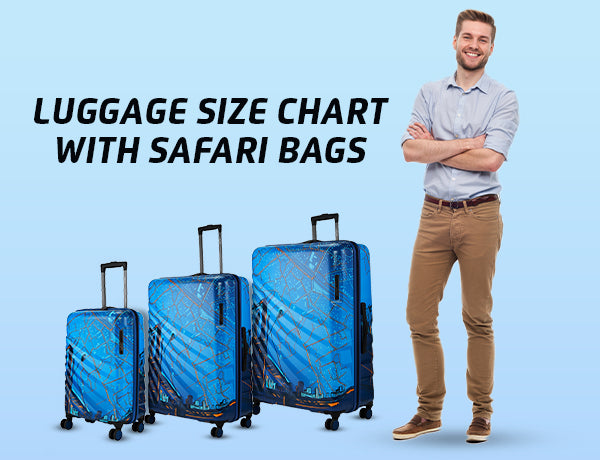
Luggage Size Chart: Ultimate Guide to Carry On & Check-in Baggage
The importance of a luggage bag size chart cannot be overstated, as improperly sized luggage can transform an anticipated journey into a hassle at the airport. From incurring additional fees for oversized and trolley bag to facing restrictions on carry-on access, understanding and adhering to additional questions related to luggage size limits is pivotal. Before heading to the airport, a quick review of our comprehensive luggage size guide ensures a smoother travel experience.
Which luggage to take when traveling?
There are tons of questions regarding selecting the right type of luggage for travel can be a daunting task, as various factors come into play to ensure a seamless journey. The duration, distance, and destination of the trip are crucial considerations. For short trips, a compact carry-on, duffle backpack or office bag may suffice, offering convenience and avoiding check-in hassles. Longer journeys, especially those involving multiple destinations, may require larger suitcases to accommodate ample belongings. The type of travel, be it business, leisure, or adventure, further influences the choice. A well-informed decision on luggage size and type not only caters to practical needs but also enhances overall travel comfort and efficiency.
Luggage Size Chart

Explore our comprehensive inch luggage size chart below, providing detailed dimensions for various bag types, ensuring you stay well-informed for your travel packing needs.
When to Opt for Checked Luggage

Choosing checked luggage is often the preferred option for extended trips where a larger wardrobe is essential. Business travelers, especially those with formal attire or multiple outfits, may find checked bags more accommodating. Vacationers planning for diverse weather conditions or various activities could also benefit from the extra space. Additionally, when carrying larger items or specific equipment necessary for the journey, opting for checked luggage ensures a smoother and more comfortable travel experience.
- Cabin + Medium + Large
Checked Baggage Allowances and Restrictions
When to opt for carry on bags.

Carry-on bags are the perfect choice for travelers in specific situations, such as short trips or weekends away. Their compact size and lightweight nature make them ideal for quick getaways. Opting for carry-on bags offers several advantages, including convenience, cost savings, and the ability to bypass the often time-consuming baggage claim process. Travelers can enjoy swift departures, avoiding the hassle of waiting for checked baggage.
Carry on luggage size chart
Personal items limitations.
Airlines typically designate a specific space beneath the seat for personal items, such as laptops , medications, books, or other essentials. This space is intended to provide convenience for passengers during the flight. However, exceeding the allotted space may necessitate the use of the overhead bin and, in some cases, could lead to additional fees. It's essential for travelers to be mindful of the dimensions and limitations imposed by airlines to ensure a smooth and hassle-free boarding experience.
In conclusion, understanding luggage size guidelines is paramount for a seamless travel experience. The choice between carry-on and checked luggage depends on factors like trip duration and specific needs. Adhering to airline regulations prevents unnecessary fees and ensures swift boarding. The convenience of personal items beneath the seat is advantageous, but travelers must be mindful of space limitations. To assist in making informed choices, it is recommended to refer to our comprehensive luggage size chart in kg or luggage size chart in cm. By consulting this, travelers can sidestep common pitfalls, enjoy cost savings, and embark on their journeys with confidence.
Frequently Asked Questions
What are the 3 sizes of luggage?
- Luggage generally comes in three main sizes: small, medium, and large. Small luggage, often referred to as carry-on, is suitable for short trips, while medium and large sizes cater to longer journeys with increased packing capacity.
What is the size limit for carry-on luggage?
- The carry-on luggage size chart varies among airlines, but common dimensions range around 22 x 14 x 9 inches (56 x 36 x 23 cm). It's crucial for travelers to check their airline's specific requirements to ensure their carry-on meets the size restrictions and avoids any inconvenience during boarding.
Continue reading

How To Set Suitcase Lock?
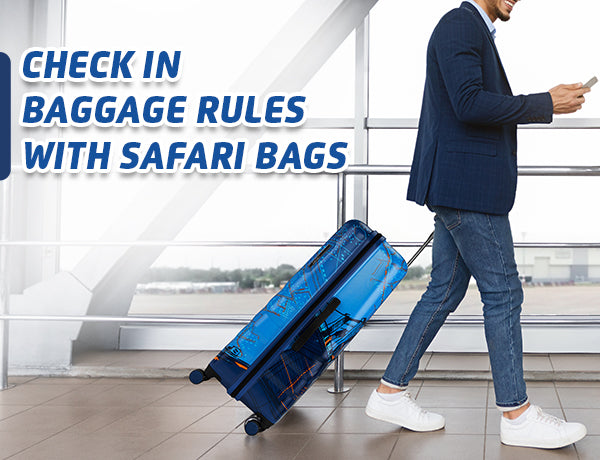
Check In Baggage Rules You Need to Know in 2024
Your cart is empty
Cookie policy
I agree to the processing of my data in accordance with the conditions set out in the policy of Privacy.
Let customers speak for us
Safari Twister Midnight Blue Trolley Bag with Dual Wheels & TSA Lock
Good initiative through direct marketing at affordable cost. Delivery mechanism is also prompt. Happy with the product, however, longevity will be known by end of my overseas trip by Jan, 2025.
Multiple pockets, premium, spacious.
I purchased two denim bags to gift to my daughter Shreya & her husband Nishaad on their wedding.I was influenced by high ratings given to these bags by those who purchased these bags earlier. Iam fully satisfied with the quality ,the look and the make of the bags. My daughter & her husband travel frequently to the US & back. I hope these bags will be useful to them in their journeys to & fro
- Credit cards
- View all credit cards
- Banking guide
- Loans guide
- Insurance guide
- Personal finance
- View all personal finance
- Small business
- Small business guide
- View all taxes
You’re our first priority. Every time.
We believe everyone should be able to make financial decisions with confidence. And while our site doesn’t feature every company or financial product available on the market, we’re proud that the guidance we offer, the information we provide and the tools we create are objective, independent, straightforward — and free.
So how do we make money? Our partners compensate us. This may influence which products we review and write about (and where those products appear on the site), but it in no way affects our recommendations or advice, which are grounded in thousands of hours of research. Our partners cannot pay us to guarantee favorable reviews of their products or services. Here is a list of our partners .
How to Maximize Your Luggage by Understanding Suitcase Sizes

Many, or all, of the products featured on this page are from our advertising partners who compensate us when you take certain actions on our website or click to take an action on their website. However, this does not influence our evaluations. Our opinions are our own. Here is a list of our partners and here's how we make money .
Table of Contents
Check in luggage size chart
How to measure luggage size, how to get free checked luggage, luggage sizes recapped.
Odds are you're going to bring along some luggage with you on your next trip. This is true whether you're boarding a plane, train or automobile — but the mode you choose could impact the bags you bring, especially when taking to the skies.
Let's look at each airline's luggage size restrictions, how to measure your bags and ways to get free checked luggage on airlines.
If you're traveling on an aircraft, where you're traveling may impact how large your bags can be. Also, international sizes aren't necessarily the same as domestic sizing requirements, so double-check your suitcase size before bringing your bags along.
Here are the measurements for check-in luggage sizes when flying with airline carriers in the United States.
Note that some airlines may also have different baggage policies based on where you're traveling. American Airlines, for instance, allows passengers flying to Australia or New Zealand to check bags up to 70 pounds. This is great news if you're traveling with a large suitcase.
» Learn more: Which airlines have the best (and worst) fees?
Large checked luggage sizes can be problematic, especially if traveling on a low-cost carrier like Spirit Airlines or Frontier Airlines.
To avoid oversized baggage fees, you'll want to measure any checked luggage before your flight. This includes both the size and the weight.
Luggage scales are a cheap and effective way to get an accurate weight measurement on your suitcases.
Measuring the size of your luggage isn't tricky. Most airlines require that your bag be 62 linear inches or less. Therefore, your bag's length, width and height cannot exceed 62 inches. This measurement includes the wheels and the handle of your luggage.
To measure your bag, you'll want to grab a tape measure. First, lay your bag flat on the ground, then measure its height. Next, you'll want to measure how long and wide it is.
If your bag has an expandable feature that you plan to use, be sure to expand it before you measure.
Once you've gathered all three data points, add them together. For example, if your bag is 24 inches tall, 20 inches long and 18 inches wide, its total linear length is 62 inches.
Note that using modern spinner bags, which include four wheels on the bottom of your suitcase, means you'll have less space within your actual bag. This is thanks to the requirement to include wheels and handles in your measurements.
If this all sounds a little overwhelming, don't worry. Most luggage companies design their bags to fit within these standards. So if your bag isn't huge or a strange shape, the odds are that it'll fit within the dimensions required by airlines.
» Learn more: Ways to avoid paying checked baggage fees
Want to avoid checked luggage fees? There are a few ways to do so.
Elite status
The first way to avoid those fees is to achieve elite status with a specific airline. Often, even the lowest elite status tiers have the advantage of free checked bags.
Active duty military and veterans can take advantage of complimentary checked bags on many airlines.
On United Airlines, for example, Silver elite members get one free checked bag on all flights, even when flying basic economy. Even better, their baggage allowance is bumped up to 70 pounds — an additional 20 pounds over those without elite status.
» Learn more: The beginner's guide to airline elite status
Co-branded credit cards
Many airlines offer co-branded credit cards that'll give you a free checked bag on flights. This includes airlines such as:
Alaska Airlines .
American Airlines .
Delta Air Lines .
United Airlines .
These cards may charge an annual fee, but if you fly just a few times yearly, it pays for itself with free checked luggage.
» Learn more: The best airline credit cards right now
Travel cards
Don't want to commit yourself to a single airline but still want free checked bags? A few different travel cards come with an annual airline fee credit.
This credit will reimburse you for expenses you incur while traveling, including checked luggage fees, seat assignments and lounge access.
The Platinum Card® from American Express is one, as is the Bank of America® Premium Rewards® credit card .
Terms apply.
» Learn more: The best travel credit cards right now
No matter how you're traveling, it's essential to understand the size of your suitcase. After all, you don't want to be maxed out on a trip before you even depart — where would you put your souvenirs?
If you plan on hopping on a plane, look at our detailed checked luggage size chart and recommendations for avoiding checked luggage fees.
How to maximize your rewards
You want a travel credit card that prioritizes what’s important to you. Here are some of the best travel credit cards of 2024 :
Flexibility, point transfers and a large bonus: Chase Sapphire Preferred® Card
No annual fee: Wells Fargo Autograph℠ Card
Flat-rate travel rewards: Capital One Venture Rewards Credit Card
Bonus travel rewards and high-end perks: Chase Sapphire Reserve®
Luxury perks: The Platinum Card® from American Express
Business travelers: Ink Business Preferred® Credit Card

on Chase's website
1x-5x 5x on travel purchased through Chase Travel℠, 3x on dining, select streaming services and online groceries, 2x on all other travel purchases, 1x on all other purchases.
60,000 Earn 60,000 bonus points after you spend $4,000 on purchases in the first 3 months from account opening. That's $750 when you redeem through Chase Travel℠.

1.5%-5% Enjoy 5% cash back on travel purchased through Chase Travel℠, 3% cash back on drugstore purchases and dining at restaurants, including takeout and eligible delivery service, and unlimited 1.5% cash back on all other purchases.
Up to $300 Earn an additional 1.5% cash back on everything you buy (on up to $20,000 spent in the first year) - worth up to $300 cash back!

on Capital One's website
2x-5x Earn unlimited 2X miles on every purchase, every day. Earn 5X miles on hotels, vacation rentals and rental cars booked through Capital One Travel, where you'll get Capital One's best prices on thousands of trip options
75,000 Enjoy $250 to use on Capital One Travel in your first cardholder year, plus earn 75,000 bonus miles once you spend $4,000 on purchases within the first 3 months from account opening - that’s equal to $1,000 in travel.

Luggage Sizes: Understanding And Choosing The Best For You
You want to buy a new suitcase but you are not sure which size to get? I’m here to help! In this post, I will tell you everything you need to consider, in order to get the perfect suitcase size.
I will also show you some good luggage options at the very end. Be sure to check those out, if you’re not sure which suitcases are worth buying.
Suitcase Sizes: The Basics
The traditional suitcase sizes range from 18” to 32”. So, there are a lot of different luggage sizes to choose from.
Each different size of luggage also has a specific luggage volume you can calculate to see how much you can fit inside it.
Let’s take a look at the breakdown.
Small Suitcase Size / Carry-On Size
- 19-22 inches
- Weekend or business trips
Suitcases that are up to 22” are considered carry-on luggage. While all larger bags are considered checked luggage .
But this is not always the case – some airlines allow larger bags inside the cabin , and will accept a 23” suitcase as a carry-on.
Medium Suitcase Size
- 25-27 inches
- Long weekend or week-long trips
A Medium sized suitcase tends to be between 25″-27″ and can easily fit everything you need for a weekend or even a week’s beach holiday.
If you are packing for a variety of climates or need cold weather gear for a ski holiday, then I find it a struggle to fit everything in. That is where a large luggage size comes in.
Large Suitcase Size
- 28-31 inches
A large luggage size is handy for when you go on trips longer than a week or just need more variety of clothing or gear with you. They are obviously larger and heavier, so be careful you still stay within the luggage weight limits for your airline.
Extra-Large Luggage Size
- 32 inches or more
For those of you who are going for even longer vacations or have bulky clothing like winter jackets or lots of different outfits, then the 32″ sized luggage is the size you want to look at. Different manufacturers have various sizes in this league, but 32 inches is the starting point.
Luggage Collections
With most luggage collections, you will see either three or four different sizes for one suitcase. That’s usually 21”, 25”, 28”, and sometimes 31” . Obviously, this is not a rule – with some brands, you’ll see smaller suitcases, and with others, you’ll struggle to find anything under 25”.
The right size for you depends on a lot of different factors, and I will do my best to cover them all in this post. And hopefully, by the end of this post, you’ll be 100% sure which size is just perfect for you!
Packing 101: Understanding What Size Luggage You Actually Need
I have a friend who I love dearly. But whenever we go away, she has three pieces of luggage. And guess what – she winds up actually using only about 40% of the items she packed.
Don’t pack for “what if” scenarios. I used to make these mistakes when I was a lot younger, and boy did I learn from them. The thing that sobered me up was when I had to carry an over-packed 30” suitcase with a broken wheel on a ferry and a train. And I had another bag that held my 70-lb laptop, and everything that did not fit in the suitcase.
I had sore arms for the next three or four days. And all of that because of the “what if” packing – turns out that the chances you will need a proper jacket and rain boots in a seaside town in the middle of July are non-existent.
You need to understand what you actually need, and what you don’t. You don’t need the third pair of jeans or the fifteenth pair of socks, or even your compression socks . And you certainly don’t need that shirt you haven’t worn since your graduation.
Once you have a really good understanding of what you actually need, you will be able to pack for long trips in small suitcases. Especially if you know some really cool packing hacks.
How Good Are Your Packing Skills?
Over the years I’ve learned to pack for two weeks in a small carry on . And you can too – it takes some time, practice, and a Marie-Kondo understanding of the things you actually need.
There are lots of useful tips and tricks you can learn that will tremendously reduce the amount of space you actually need in a suitcase. One of the best tricks I learned was to roll my clothes – if you haven’t tried this already, you’re missing out!
The next time you go pack your suitcase, try rolling your clothes instead of folding them. Not only will it save you a lot of space in your luggage, but it also keeps the clothes from wrinkling.
Another incredibly useful trick I learned was to put my underwear and socks into plastic bags and then stuff those inside my shoes. I also realized that this doesn’t work with all kinds of shoes, like soft Converse sneakers or espadrilles. But it works like a charm with bulkier footwear, and it really helps you utilize your suitcase to the max.
I don’t know about you, but before I learned this trick I used to pack my socks and underwear in the mesh zippered pockets on the cover of a softshell, or on the divider of a hardshell suitcase . Now I use that space for cosmetics, towels, or swimsuits, depending on what I’m packing for.
When you get really good at packing, you will realize that you don’t actually need a 32” suitcase for a two-week holiday.
How Are You Travelling?
Are you flying somewhere, or are you taking a train/driving?
And if you are flying, does your ticket allow for a checked bag? I find it easier to justify packing a big suitcase to myself if I’ve bought a ticket that includes a checked suitcase. But that’s not always the case, especially with short flights and budget airlines.
In this case, I’d say that the size of your suitcase depends mostly on your ticket. If you already paid for a checked bag, then by all means bring a 28” suitcase and pack everything you want inside it. But if your ticket doesn’t allow for checked luggage, you will save time and money if you opt for a carry-on. Especially if you’re going on a shorter trip, and you don’t need to bring too much stuff in the first place.
But if you are traveling by train or bus, then you’re better off getting a smaller suitcase. Think about it –you’ll have to drag that thing to the train station, then all the way to the hotel. Maybe you’re even switching between trains, or getting on a ferry at one point?
The lighter your luggage is, the easier it is for you to move around. You won’t be stressed out and you won’t be in pain if you’re not carrying a 40-lb suitcase.
If you’re driving somewhere, think about the trunk space . Sure, there’s plenty of room for your luggage if it’s just you and your partner, but if you’re going away with a group of people… One time I went on a holiday with 4 friends, in one car. None of us were allowed to bring a big suitcase because there simply wasn’t enough room in the trunk. Talk about being squashed like sardines.
This is something you need to think about – if you are getting in a car with three or four more people, you really need to pack light. The trunk will fill up really quickly, and there will be very little (if any) space in the back seat. And trust me, you don’t want to ride for 5 hours with your bags under your seat.
What Do You Need The Suitcase For?
Do you need a suitcase for a specific trip, or are you just looking to expand your luggage collection?
If you are buying a suitcase for one particular trip, then it makes sense to get a size that is just right for that trip. If you’re going away for a really long time, then you need a large bag. But if your trip is two weeks or under, you can manage with a 25” suitcase.
If you are buying a suitcase because you want to add another one to your existing luggage collection, make sure you get something you will use . Don’t get a 32” suitcase just because you don’t own one – if you’ve got this far without it, chances are you won’t use it too often. And if you are not using it often, then you are not getting your money’s worth.
Instead, consider which size you’re currently using most frequently. And then get another one – it’s good to have a backup if your favorite suitcase gets damaged beyond repair . Plus, if you’re always traveling with a 21” carry-on, then you will definitely get your money’s worth if you buy another one of those.
It’s kind of like buying perfume online – would you rather buy another bottle of your favorite perfume, or order something you’ve never smelled before and risk not liking it?
When Do You Travel Most Often?
Are we talking about the summer or winter holidays? Because the difference is huge.
Summer clothes are lightweight, thin, and take up very little space. But winter clothes are bulkier and heavier – one down jacket will take up as much space as a pair of jeans, a couple of tops, and a beach towel.
Therefore, it makes perfect sense to buy a larger suitcase if you’re going away to the mountains. Especially if you want to go skiing or snowboarding, and you need all the additional equipment. This is actually one of the few scenarios where I will tell you that it’s better to buy a really big suitcase.
For most other scenarios, you will rarely need something larger than 28” max. Especially in the spring and summer, when you’re packing thin and lightweight clothes, and you can wear that one jacket you want to bring.
Who Are You Travelling With?
Do you travel alone? With friends? With a spouse?
If you travel alone, it makes more sense to get a small suitcase. You don’t really have people that can carry it for you, and it’s a lot easier to go places with small and lightweight luggage.
But if you’re traveling with a partner or just one other person, then your best bet is splitting a suitcase with them. I always recommend this to couples and they always thank me – why would you bring two small suitcases, when you can fit clothes for both of you in one large bag?
You can alternate who carries the suitcase so neither of you gets too tired, and both of you can also have a backpack or a smaller duffel for any additional stuff you need.
This is a very useful trick for air travel – you don’t have to pay for two big suitcases. Instead you can have one checked bag and two carry-ons. And that can hold enough things for about a month.
How Much Do You Shop?
Do you only buy a couple of souvenirs , or do you go cray-cray if you see a hot sale?
If you plan to do a lot of shopping on your trip, then definitely go for a larger suitcase, preferably one with expandable capacity.
But don’t go too big – go for one or two sizes larger. And don’t pack it fully. Leave some room inside, so that you can fit all the things that you buy on your trip.
Even if you don’t normally shop too much on your trips, you will benefit from having an expandable suitcase. You never know – maybe you’ll find that one pair of sneakers you’ve been eyeing for months but are sold out everywhere else.
Where Are You Staying?
Are you staying in a hotel or AirBnB ? Maybe you’re even visiting a friend or family?
Here’s why I’m asking – if you’re staying someplace where you have a washer, you don’t need to bring too many clothes. Instead of packing 7 shirts for 7 days, you can just bring 4 and then wash them and wear them again.
So, if you have access to a washing machine, you can pack less stuff in a smaller suitcase. But if you’re staying in a hotel, then you don’t have that luxury. In that case, you will probably need a large suitcase size, which can fit all of your clothes.
Most Important Points
- Always go for the smallest suitcase size you feel comfortable with
- Don’t buy a giant suitcase just because you don’t have one
- Don’t pack for “what if” scenarios – if you wind up missing something, you can always buy it
- If you’re traveling with a partner or a friend, the two of you can split a really big suitcase
- If your plane ticket includes a checked bag go nuts
- If your plane ticket doesn’t include a checked bag get a carry-on
- If you’re traveling alone get a small suitcase
- If you are traveling in the winter, get a bigger suitcase because boots, jackets, and sweaters take up a lot more space than sundresses and shorts.
- If you have access to a washing machine, you don’t need too many clothes
I think that covers most of what I was saying earlier. Anyway, let’s check out some suitcases.
Top Product Overview
Best sized suitcases for travel, american tourister curio.

This is one of my favorite budget options. It’s a hardside suitcase, and it is available in three sizes – 20”, 25” and 29 ”. All of the suitcases are made from polypropylene , and they are really lightweight. The only downside to these is that they don’t have expandable capacity , and you will need to make the best of what you get.
At the moment, all three Curio suitcases are discounted and are under $100. SEE ALSO: American Tourister Curio Detailed Review
Delsey Helium Aero

Delsey’s Helium Aero luggage is a great durable option . The suitcases are made from Polycarbonate, which is the sturdiest material for luggage. It bends upon impact – you can literally dent the shell and then pop it back in place. These suitcases are available in four different sizes , and they all feature e xpandable capacity.
Overall, a great choice for air travel.
SEE ALSO: Delsey Helium Aero Full Review
Samsonite Solyte DLX

The Samsonite Solyte DLX is definitely one of the best and most durable soft side suitcases you can get. It’s made from 100% rugged polyester weave, which is a very popular material for sturdy soft luggage. It has excellent tear resistance , and it is also water-resistant, which is why it’s so popular.
Samsonite Solyte DLX suitcases are available in three sizes, they feature spinner wheels and all of them have the expandable capacity.
Travelpro Crew 11

Travelpro is a brand that manufactures luggage for airline employees. If it’s good enough for them, then it’s good enough for you, right?
The Crew 11 suitcases are a very popular option. They are softshells with spinner wheels and multiple compartments and pockets. The suitcases are made from ballistic nylon , and they are very durable.
You can get these in a lot of different sizes, but the four I featured are the most popular options.
SEE ALSO: Travelpro Crew 11 Review (Softsides & Hardsides)
Samsonite Omni PC

The Samsonite Omni PC is a very popular suitcase. It’s a Samsonite that you can get for less than $100 – I think that’s what appeals most to people.
These are hardside suitcases , with a rather unusual shell design. But thanks to their diamond-pattern exterior, they are very scratch-resistant. All three Omni suitcases feature s pinner wheels, double packing compartments and expandable capacity.
If you’re looking for a high-quality suitcase at an affordable price, the Omni is the way to go.
Luggage Sizes FAQ
In this section, I’ll cover some of the most frequently asked questions about luggage sizes regarding both carry-ons and checked bags.
Are Suitcases Measured Diagonally?
No, suitcases are usually not measured diagonally . Instead, if airline personnel think your bag is too big for a carry-on, they will ask you to put it in a sizer that restricts height and depth of luggage. In practice, this means that you can get away with luggage that is an inch or two wider than it should be.
Also, suitcases are measured with wheels, handles, and other protrusions, so when you are shopping for a suitcase, be sure to look for external dimensions and not case dimensions.
Case dimensions only account for the size of the packing compartment – they don’t account for the wheels and handles. In general, the wheels and handles add about 1.5” to the bag, and that’s your difference between a carry-on and checked luggage.
Additionally, some airlines will restrict luggage based on linear size . Instead of measuring the diagonal, liner size is just adding up all the different dimensions. For example, most airlines will restrict checked baggage to 62” linear – this could be a 27” x 21” x 14” suitcase, or a 26” x 20” x 16” one. For carry-ons, the usual restriction is 45” linear.

What’s The Biggest Suitcase Size?
The biggest suitcase size is 32”. These are extra-large checked suitcases that often measure 31-32” with the wheel and handle, and they are rare. Most brands will have a 28” suitcase as their biggest option – these bags often have a capacity of 90-100 liters, which is more than enough for the average person.
Why doesn’t everyone make extra-large checked because? Because they’re not very popular. A 28” suitcase is still big enough to get you through a 20-day trip, but it’s significantly lighter and easier to maneuver than a 32” one. Also, the bigger and heavier your luggage is, the more likely you are to go over the weight limit for checked bags and incur a penalty fee.
The actual biggest suitcase in the world was built in 1999, and it measures 13.33 x 8.75 x 4.16ft. It’s obviously not for sale and it was built just for the purposes of getting a Guinness World Record, but hey – now you know a useless fun fact!
What Is Carry-On Suitcase Size?
The maximum allowed size for a carry-on suitcase is determined by the airline, but in most cases it is 45” linear. For most airlines, the maximum height of a carry-on suitcase is 22”, including the wheels and handles. However, and I can’t stress this enough, it is very important that you always check what the policy of the airline you are flying with.
Some will allow only bags up to 21”, others won’t let you carry on anything wider than 15”, and some (like Southwest) will let you carry on bags up to 24”. It varies from airline to airline, but a 21” suitcase is generally considered a carry-on almost everywhere.
What Is The Smallest Suitcase Size?
The smallest suitcase size is 18” for proper suitcases . These are mini carry-ons that work best for overnight trips because they have a very small capacity. Also, this is the standard size of suitcases for children . You can go even smaller, but then we’re not really talking about proper suitcases.
Instead, we’re talking about underseat bags. Some brands will put as much effort into these as they put into their other luggage, so you can buy a proper underseat suitcase with a multi-stage handle, spinner wheels, and two packing compartments. These mini suitcases are usually 16” or smaller.
What Happens If Carry-On Is Too Big?
If your carry-on suitcase is too big and you’re not allowed to bring it inside the cabin, you will be forced to check your bag . If your ticket allows for a checked bag and you don’t have one, you don’t need to pay an extra fee. But if your ticket doesn’t include checked luggage, you will need to pay for it.
Make a point of checking the carry-on restrictions of any airline you travel with, and you will avoid nasty surprises. It’s especially important to this if you’re flying with a local airline that uses smaller aircrafts. Smaller planes have smaller overhead bins and even standard carry-ons won’t always fit inside them.
It’s worth noting that slightly oversized carry-ons make it inside the cabin all the time. It depends on how strict the airline is with enforcing the rule, but also who’s working that particular day, and whether they’re in a good mood. As long as your carry-on is not visibly oversized (bulging, extended, etc.), you can easily sneak it onto the plane.
What Happens If Carry-On Is Too Heavy?
If your carry-on suitcase is too heavy, you will most likely be forced to check it at the gate. This will also incur a checked baggage fee, and depending on the weight of the carry-on, you might also get an overweight baggage fee. But the latter will happen only if your carry-on exceeds the maximum weight for checked bags, which is usually 50 lbs.
Considering that carry-ons have a significantly smaller capacity than checked luggage, it’s almost impossible to make them weigh more than 50 lbs.
Most airlines have a weight limit of 20 lbs for carry-on bags but be sure to double-check if this is the case with the airline you are traveling with. Some airlines don’t have any weight restrictions for carry-ons, and you could get away with a suitcase that’s entirely packed with bricks. It generally depends on the size of the aircraft – if you’re flying in a small plane, an overweight carry-on is trouble.
You can avoid all of this by simply weighing your carry-on at home and taking out any items that are making it overweight. Additionally, a few ounces or even a pound extra shouldn’t really matter – most airlines don’t even weigh carry-on luggage, unless it’s obvious that it is too heavy.
Pin It For Later!
- Overview Guide
- 1 Week Itinerary
- Train Journeys
- Epic Drives
- Stunning Lakes
- Historic Castles
- Lauterbrunnen
- Grindelwald
- Chocolate Tours
- Swiss National Park
- Majestic Mountains
- Spectacular Waterfalls
- Famous Things
- Tasty Fondue
- 10 Day Itinerary
- Cherry Blossoms
- Tokyo Shrines
- Dos and Don’ts
- Osaka Guide
- Osaka Itinerary
- Osaka or Kyoto
- Kyoto Day Trips
- Matsumoto Castle
- Tokyo Luxury Hotels
- Island Hopping
- Best Campsites
- Driving Tips
- Beaune, France
- Barcelona Itinerary
- Spain Itinerary
- Greece Itinerary
- Italy Road Trips
- Berlin Day Trips
- Norway Northern Lights
- Netherlands National Parks
- Mostar, Bosnia
- Best Airlines
- Midwest Ski Resorts
- Florida RV Parks
- Washington RV Parks
- Oregon RV Parks
- Utah Camping
- Texas Camping
- Chicago National Parks
- East Coast National Parks
- Colorado National Parks
- Joshua Tree
- Yellowstone
- Alberta Hikes
- Flashlights
- Water Filters
- Sleeping Pads
- Solar Lanterns
- Tent Brands
- 4-Person Tents
- 4 Seasons Tents
- Backpacking Tents
- Beach Tents
- Cabin Tents
- Multi-room Tents
- Pop-up Tents
- Truck Bed Tents
- Underwear (Men)
- Backpacks Under $100
- Microspikes
- Boonie Hats
- In The World
- New Zealand
- Hardisde Luggage
- Lightweight Luggage
- Luggage Sets
- Spinner Luggage
- Durable Suitcases
- Duffel Bags
- Kids Luggage
- Teen Luggage
- Space Saving Luggage
- Business Carry-Ons
- Garment Carry-Ons
- Suitcases Under $50
- Travel Briefcase
- Zipperless Suitcases
- Rolling Briefcase
- Luggage Straps
- Luxury Brands
- American Tourister
- AmazonBasics
- Delsey Chatelet
- Anti-Theft Backpacks
- Backpacks Under $50
- Baby Carrier Backpacks
- Cooler Backpacks
- Backpacking Backpacks
- Climbing Backpacks
- Backpacks for Back Pain
- Beach Backpacks
- Hiking Backpacks
- Business Travel Backpacks
- Laptop Backpacks
- Backpacks for Tablets
- Commuter Backpacks
- Travel Backpacks (Men)
- Travel Backpacks (Women)
- Waterproof Backpacks
- Wheeled Backpacks
- Down Jackets
- Down Parkas
- Fleece Jackets
- Hardshell Jackets
- Rain Jackets
- Softshell Jackets
- Eco Friendly Jackets
- Gore Tex Alternatives
- Heated Jackets
- Lightweight Jackets
- 3-in-1 Waterproof Jackets
- Parajumper Jackets
- Rain Poncho
- Ski Jackets
- Travel Hoodies
- Travel Jackets
- Winter Coats
- Helly Hansen
- Mammut Jackets
- Patagonia Nanopuff
- Survival Jackets
- Flower Captions
- Waterfall Captions
- Tree Captions
- Sunset Captions
- Sunflower Captions
- Rainbow Captions
- Paddle Boarding Captions
- Hot Air Balloon Captions
- Kayaking Captions
- Airplane Captions For Instagram
- Forest Captions
Advertiser Disclosure
Many of the credit card offers that appear on this site are from credit card companies from which we receive financial compensation. This compensation may impact how and where products appear on this site (including, for example, the order in which they appear). However, the credit card information that we publish has been written and evaluated by experts who know these products inside out. We only recommend products we either use ourselves or endorse. This site does not include all credit card companies or all available credit card offers that are on the market. See our advertising policy here where we list advertisers that we work with, and how we make money. You can also review our credit card rating methodology .
2024 Checked Luggage Size Chart and Allowances for 62 Airlines [Dimensions, Sizes and More]
Alex Miller
Founder & CEO
297 Published Articles
Countries Visited: 34 U.S. States Visited: 29
Keri Stooksbury
Editor-in-Chief
41 Published Articles 3371 Edited Articles
Countries Visited: 50 U.S. States Visited: 28
Michael Y. Park
25 Published Articles 320 Edited Articles
Countries Visited: 60+ U.S. States Visited: 50
![average travel bag size 2024 Checked Luggage Size Chart and Allowances for 62 Airlines [Dimensions, Sizes and More]](https://upgradedpoints.com/wp-content/uploads/2023/01/Luggage-Choice.jpg?auto=webp&disable=upscale&width=1200)
Table of Contents
Checked luggage allowances by airline, can i prepay for baggage, recommended cards that reimburse your baggage fees, checked luggage options.
We may be compensated when you click on product links, such as credit cards, from one or more of our advertising partners. Terms apply to the offers below. See our Advertising Policy for more about our partners, how we make money, and our rating methodology. Opinions and recommendations are ours alone.
Key Takeaways
- Airline policies for checked luggage sizes and weights vary, with most allowing bags up to 62 linear inches and 50 pounds, though these limits can differ by airline and route.
- Oversized or overweight bags incur additional fees, which can be substantial, making it important for travelers to check specific airline policies before packing.
- Understanding airline baggage rules helps avoid unexpected charges and issues during check-in boarding.
With no universal set of rules for checked luggage allowances, you need to review what you’re permitted to bring with you every time you travel in order to avoid excess charges.
Allowances can differ from airline to airline, with some allocating a total weight allowance and some restricting passengers to a specific number of pieces. Airline policies can also vary depending on the route and will nearly always vary based on the cabin you’re traveling in.
Your ticket will give you the most accurate information for your specific flight. If baggage details are not included on your ticket, you can check out our handy table below that details allowances for over 60 popular airlines. Where available, you can also click the airline name for a more detailed overview of the airline’s baggage policy, including excess charges and frequent flyer allowances.
When talking about baggage allowances, many airlines refer to “maximum linear dimensions” or something similar. This is merely the number you get when you add together the length, width (or height), and depth of a piece of luggage. For example, if you had a suitcase that’s 26 inches long, 20 inches wide, and 16 inches deep, then its linear dimensions are 62 inches, or right at the maximum for many airlines.
Traveling light? We’ve also covered carry-on luggage allowances with a similar size chart.
Your airline may allow passengers the ability to prepay luggage online for less than at the airport. Individual airlines’ baggage policies can be found by clicking the airline name in the preceding table or by visiting the airline’s website.
If you will be paying to check a bag on your next flight, or if your luggage is overweight or oversized, use one of the recommended Capital One cards below so that you can be reimbursed for the cost. Each card detailed allows you to redeem Capital One miles for 1 cent each as a statement credit against travel purchases made in the previous 90 days.

The Capital One Venture X card is an excellent option for travelers looking for an all-in-one premium credit card.
The Capital One Venture X Rewards Credit Card is the premium Capital One travel rewards card on the block.
Points and miles fans will be surprised to see that the Capital One Venture X card packs quite the punch when it comes to bookings made through Capital One, all while offering the lowest annual fee among premium credit cards.
Depending on your travel goals and preferences, the Capital One Venture X card could very well end up being your go-to card in your wallet.
- 10x miles per $1 on hotels and rental cars purchased through Capital One Travel
- 5x miles per $1 on flights and vacation rentals purchased through Capital One Travel
- 2x miles per $1 on all other purchases
- $395 annual fee ( rates & fees )
- Does not offer bonus categories for flights or hotel purchases made directly with the airline or hotel group, the preferred booking method for those looking to earn elite status
- Earn 75,000 bonus miles when you spend $4,000 on purchases in the first 3 months from account opening, equal to $750 in travel
- Receive a $300 annual credit for bookings through Capital One Travel, where you'll get Capital One's best prices on thousands of trip options
- Get 10,000 bonus miles (equal to $100 towards travel) every year, starting on your first anniversary
- Earn unlimited 10X miles on hotels and rental cars booked through Capital One Travel and 5X miles on flights and vacation rentals booked through Capital One Travel
- Earn unlimited 2X miles on all other purchases
- Unlimited complimentary access for you and two guests to 1,300+ lounges, including Capital One Lounges and the Partner Lounge Network
- Use your Venture X miles to easily cover travel expenses, including flights, hotels, rental cars and more—you can even transfer your miles to your choice of 15+ travel loyalty programs
- Enjoy a $100 experience credit and other premium benefits with every hotel and vacation rental booked from the Premier Collection
- Receive up to a $100 credit for Global Entry or TSA PreCheck ®
- APR: 19.99% - 29.99% (Variable)
- Foreign Transaction Fees: None
Capital One Miles

Get 2x miles plus some of the most flexible redemptions offered by a travel credit card!
The Capital One Venture Rewards Credit Card is one of the most popular rewards cards on the market. It’s perfect for anyone in search of a great welcome offer, high rewards rates, and flexible redemption options.
Frequent travelers with excellent credit may benefit from this credit card that offers a lot of bells and whistles. And it offers easy-to-understand rewards earning and redemption.
- 5x miles per $1 on hotels, vacation rentals, and rental cars booked through Capital One Travel
- Global Entry or TSA PreCheck application fee credit
- $95 annual fee ( rates & fees )
- Limited elite benefits
- Enjoy $250 to use on Capital One Travel in your first cardholder year, plus earn 75,000 bonus miles once you spend $4,000 on purchases within the first 3 months from account opening - that’s equal to $1,000 in travel
- Earn unlimited 2X miles on every purchase, every day
- Earn 5X miles on hotels, vacation rentals and rental cars booked through Capital One Travel, where you'll get Capital One's best prices on thousands of trip options
- Miles won't expire for the life of the account and there's no limit to how many you can earn
- Use your miles to get reimbursed for any travel purchase—or redeem by booking a trip through Capital One Travel
- Enjoy a $50 experience credit and other premium benefits with every hotel and vacation rental booked from the Lifestyle Collection
- Transfer your miles to your choice of 15+ travel loyalty programs

The card offers unlimited miles at 1.25x per $1 and no annual fee. When you consider the flexible rewards, frequent travelers come out on top.
Interested in a travel rewards credit card without one of those pesky annual fees? Then say hello to the Capital One VentureOne Rewards Credit Card.
In addition to no annual fee, the Capital One VentureOne card offers no foreign transaction fees.
But is this card worth its salt, or is it merely a shell of the more popular Capital One Venture card?
- No annual fee ( rates & fees )
- No foreign transaction fees ( rates & fees )
- Ability to use transfer partners
- Weak earn rate at 1.25x miles per $1 spent on all purchases
- No luxury travel or elite benefits
- $0 annual fee and no foreign transaction fees
- Earn a bonus of 20,000 miles once you spend $500 on purchases within 3 months from account opening, equal to $200 in travel
- Earn unlimited 1.25X miles on every purchase, every day
- Earn 5X miles on hotels and rental cars booked through Capital One Travel, where you'll get Capital One's best prices on thousands of trip options
- Enjoy 0% intro APR on purchases and balance transfers for 15 months; 19.99% - 29.99% variable APR after that; balance transfer fee applies
- APR: 19.99% - 29.99% (Variable),0% intro on purchases for 15 months

Hot Tip: To view more checked bags, check out our article on the best checked luggage bags for travelers .
The information regarding the Capital One Venture X Rewards Credit Card was independently collected by Upgraded Points and not provided nor reviewed by the issuer. The information regarding the Capital One Venture Rewards Credit Card was independently collected by Upgraded Points and not provided nor reviewed by the issuer. The information regarding the Capital One VentureOne Rewards Credit Card was independently collected by Upgraded Points and not provided nor reviewed by the issuer.
Related Posts
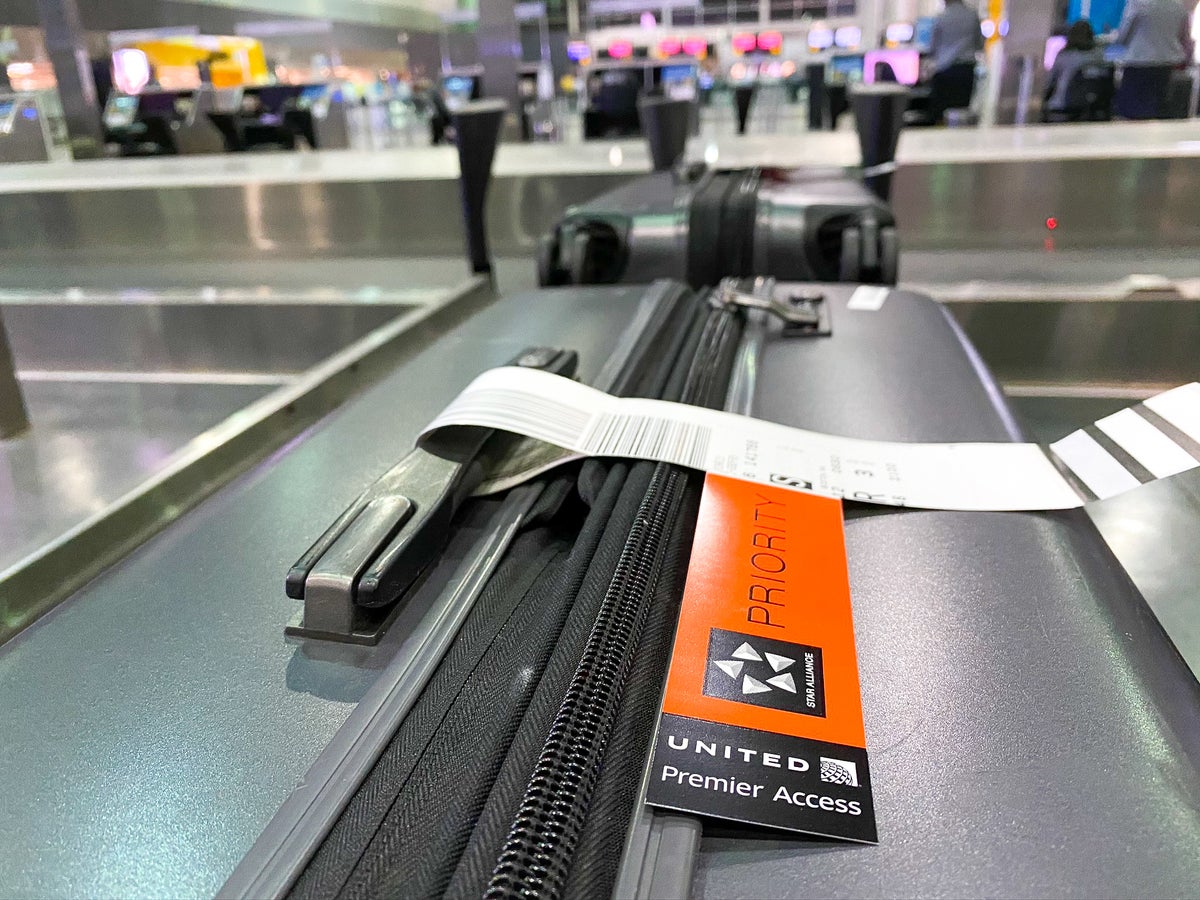
UP's Bonus Valuation
This bonus value is an estimated valuation calculated by UP after analyzing redemption options, transfer partners, award availability and how much UP would pay to buy these points.
Shop by Department
- Holiday Gift Guide
- Kids & Baby
- Bed & Bath
- Plus & Petite
- Sports Fan Shop
- Sale & Clearance
- Go to my Account
Macy's Credit Card
- Order History
- Star Rewards
- More Gift Ideas
Wedding Registry
- Best Luggage Brands
Luggage Sizes
- Luggage Types
- Carry-On Luggage Sizes
- Underseat Luggage
- Back to Main
- What Are TSA Locks?
- The Savvy Traveler: Best Luggage For Me
- On The Go Traveler: Travel Backpacks
- The Tech Traveler: Luggage & Travel Tech
- Pro Packer: Best Way to Pack A Suitcase
Are you having trouble deciding what size suitcase to tote on your next vacay? Take a load off! Macy’s Luggage Guide is here to help. We’re crushing on luggage sets that include multiple suitcase sizes to meet most of your travel needs. Whether you’re going away for a weekend or two weeks, we have the ideal luggage sizes from Tumi, DKNY, Tommy Hilfiger, London Fog and more.
How to Choose the Right Luggage Size?
1. Underseat Luggage. Are you taking an overnight trip? Underseat luggage is a great way to stow your laptop, cosmetics and a change of clothes. From duffel bags to weekenders, they’ll fit right underneath the seat in front of you for easy access. Dimensions : Most styles measure 15” to 17” in height including the wheels.
2. International Carry-On Suitcases. Are you planning an escape overseas for a long weekend? Don’t leave home without an international carry-on. These suitcases are a bit smaller than domestic carry-ons and meet regulations for most international carriers. You’ll be able to pack a couple of outfits, a pair of shoes and your beauty products. We highly recommend checking out expandable carry-on luggage. Dimensions : Most international carry-ons are 17” to 21” high including the wheels.
3. Domestic Carry-On Suitcases. If you’re traveling within the US, you’re allowed a carry-on that’s a tad larger. However, you’ll still have to be selective with your wardrobe choices. These small suitcases can accommodate just under a week’s worth of items. If you’re struggling to squeeze in everything, travel with a larger personal item like a backpack or tote. Dimensions : Domestic carry-ons are typically 22” to 24” in height including the wheels.
4. Medium Check-In Suitcases. Traveling for about a week? You’ll need a medium check-in suitcase to hold all your must-haves plus a few extras. To avoid mix-ups at baggage claim, you’ll want to get a medium suitcase with a bold color or print. If you’re not ready to make that type of commitment, you can also get a bright luggage tag or whimsical luggage cover. Dimensions : Medium check-in suitcases are about 24” to 26” high not including the wheels.
5. Large Check-In Suitcases. Are you going away for about two weeks? Lucky you! We suggest you pack your things in a large check-in suitcase . You’ll need plenty of options for day and night activities, plus workout gear. To avoid overweight fees, totally get a luggage scale to weigh your large suitcase before your trip. Remember, most airlines have a 50-pound limit for checked luggage. Dimensions : A large check-in suitcase will generally be 27” to 33” tall not including the wheels.
Average Suitcase Sizes
Helpful Hint : The height was taken from the bottom of the wheels to the top of the suitcase. For the approximate measurements on a particular suitcase, please refer to the product description page.
Travel Tip : Remember to check with your airline for their luggage size regulations before you take off.
Customer Service
- Help & FAQs
- Order Lookup
- Shipping & Delivery
- Change Location
- Macy's Card Services
- Pay Your Credit Card Bill
- Cardholder Benefits
- Apply for Macy's Credit Card
- Stores & Services
- Locations & Hours
- Store Events
- Tell Us What You Think
- Macy's Backstage
- Personal Stylist
Macy's Inc.
- Corporate Site
- Greenliving
- Macy's Gives
© 2020 macys.com is a registered trademark. All rights reserved. Macys.com, LLC, 680 Folsom St. San Francisco, CA 94107. Macy's Credit and Customer Service, PO Box 8113, Mason, Ohio 45040. Request our corporate name & address by email.
- Order Tracking
Your cart is empty
SHOP BY CATEGORY
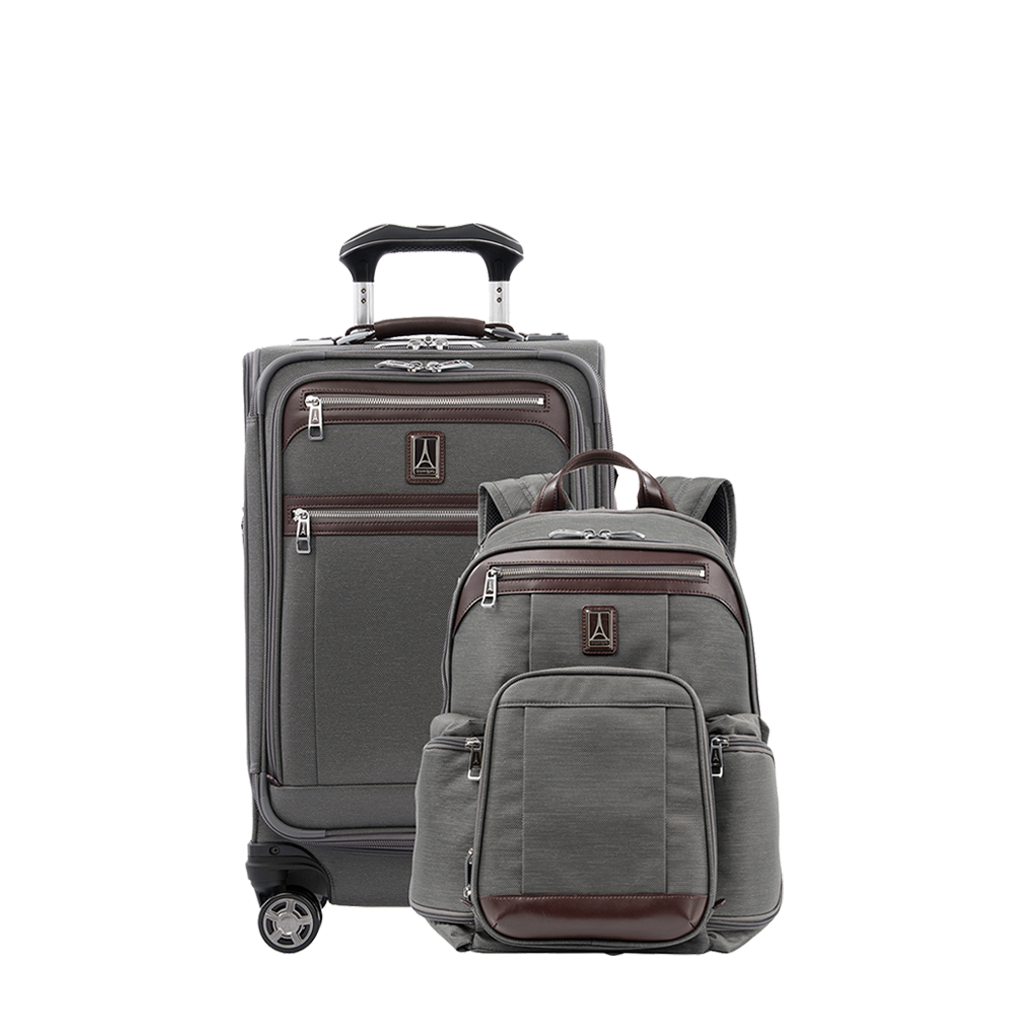
CHECKED LUGGAGE
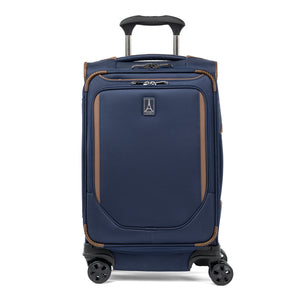
CARRY-ON LUGGAGE

- Aviation Professionals
Guide to Luggage Size

Trying to figure out which luggage is the right size for your needs? Below, we lay out what you need to know about luggage sizing, airline size limits, carry-on vs. checked bags, what fits in an overhead bin or under the seat onboard the plane and more–all to help you determine which suitcase or companion luggage is the best size for you.
Luggage, like shoes, should fit well. You’ll be travelling distances and depending on it to carry what you need wherever you are going. But shopping for new luggage today isn’t as simple as picking a large or small suitcase.
For travelling light, there are compact travel totes , weekenders , and carry-on bags . Check-in luggage also comes in a variety of styles and shapes, including suitcases of various sizes with hard shells or softsides –some expandable, some not. Maybe a duffle bag that rolls are better for your needs, or a garment bag … There is so much to consider even before you get to the rainbow of available colours.
The right luggage can save hassle, time and plenty of money. Start by knowing what size you need, then move on to finding what you want.
Frequently asked questions we get from travelers on how to choose the right luggage size:
What is the biggest suitcase size can I carry on? Which luggage size is right for a weekend or 3-day trip? What are the size and weight limit for checked baggage? How many carry-on bags can I bring? How much fits in medium- or large-size checked bags? Are size limits different internationally or for different airlines? Is there a baggage fee for certain bags and not for others? These are all great questions that we will answer along with other important information to help you choose the right luggage size and style for you.
Taking Measures
To start, let’s establish what defines suitcase size–and how to measure yours.

Carry-Ons and Personal Items

Carry-on Luggage Size Limits

At Travelpro®, we test our carry-on luggage in the same sizer bins found at airports worldwide, making it easy for you to find a bag that doesn’t exceed carry-on size limits. Find detailed information on the dimensions of all our luggage on the individual product pages.
Benefits of Carry-On Luggage

There are plenty of reasons some travellers swear by carry-on luggage as “the only way to go”:
Baggage fees.
Carrying on can help you avoid baggage fees. With few exceptions, checked baggage fees are commonplace today, while most–but not all–major airlines allow one free carry-on bag that fits in the overhead compartment. Personal items fly free but must fit under the seat in front of you on the airplane. While standard carry-on luggage is too large to fit under the seat, Travelpro® makes underseat luggage that packs plenty while remaining compact. The size limits of personal items vary by airline. Check with your carrier prior to flying.
Saving time is another reason travellers carry on instead of checking luggage. Having your baggage onboard means you won’t have to corral around the baggage carousel waiting to collect your suitcase… or hoping it made it.
Being in constant possession of your bag, reduces the risk of loss or theft. Layovers increase the chances for your bag to get lost or sent to the wrong place, which can unnerve even the most seasoned traveller.
There is generally no weight limit for carry-on bags and the airline will probably not weigh your in-cabin luggage. But you need to be able to lift it to place it in the overhead compartment unassisted.
On the Flip Side
Travelling light can be great, but being restricted to a carry-on is no fun if you can’t bring what you need. Sure, you can wear a pair of jeans a few times, and you probably don’t require four pairs of shoes for a three-day jaunt. Still, packing everything you need in a carry-on for a week or longer trip may not be ideal, unless you plan to do laundry or buy necessities at your destination.
Checked Baggage
Check-in luggage is anything you are taking but not carrying into the cabin with you–from golf clubs to a cardboard box. Sports equipment and instruments that don’t meet carry-on size restrictions all qualify as checked luggage. As such, these items will be placed in the cargo hold and inaccessible to you during flight.
Items that are prohibited from being in the cabin must also be in your checked luggage, including lithium batteries, liquids over 3.4 ounces, weapons and anything that could be used as a weapon, like baseball bats, metal knives, box cutters and even pocket knives.
Checked Baggage Size and Weight Limits

Checked Baggage Fees
Checked baggage fees cost passengers over $5 billion last year. Most US-based airlines charge for checked baggage, except Southwest Airlines which allows up to two free checked bags per passenger. Baggage fees average around $30 per bag per segment, depending on the airline. You’ll be charged per direction, regardless of whether you fly nonstop or have a connection.

Baggage Fee Exceptions
Many airlines waive checked bag fees for travellers flying Business or First Class, active duty military personnel and those who have elite status with the airline. Checking baggage that exceeds the standard weight limit adds overweight fees, and if your bag weighs over 100 pounds, it probably won’t fly. Airlines cap their weight allowances, even for overweight baggage. Whether your bags fly free or cost extra, they are still limited to the 62-linear inch size limit.
Choosing the Right Size Checked Bags
You can check in any size luggage, but the most common checked bags are larger than typical 22” x 14” carry-on bags. The most popular size check-in luggage is 25- to 29-inches tall and various widths. Medium-sized check-in luggage measures 25-26” tall and around 18” wide.* One medium-sized suitcase will generally hold what you need for a week-long getaway. (See our sizing chart for more detail.) Large check-in luggage is great for longer trips, lots of gear or multiple people. Large suitcases, including trunks and large duffel bags, measure 26” and taller*, giving you loads of packing space. Mind the rules though! Large bags make it easy to exceed weight and size limits. *For exact measurements on a particular bag, please refer to the individual product description page.
Tips for Buying Check-in Luggage
Durability is important for any size bag, though checked bags take the most abuse in transport. Travelpro® luggage is engineered for resilience and backed by dependability warranties. The larger the bag, the heavier it can be when packed. Look for luggage that rolls easily on strong wheels with sturdy extension handles that can be used to stack and secure smaller luggage on top.
Check out our handy chart below for luggage sizing by contents and length of trip:
*Number of outfits depends on packing style
🧭 Explore Our Guides
Luggage shopping guides.

Beginner Travel Tips
Airline tips.

Luggage Repair & Maintenance
- Travel recommendations
- The taste of travel
- Tips & tricks
- Travel experiences
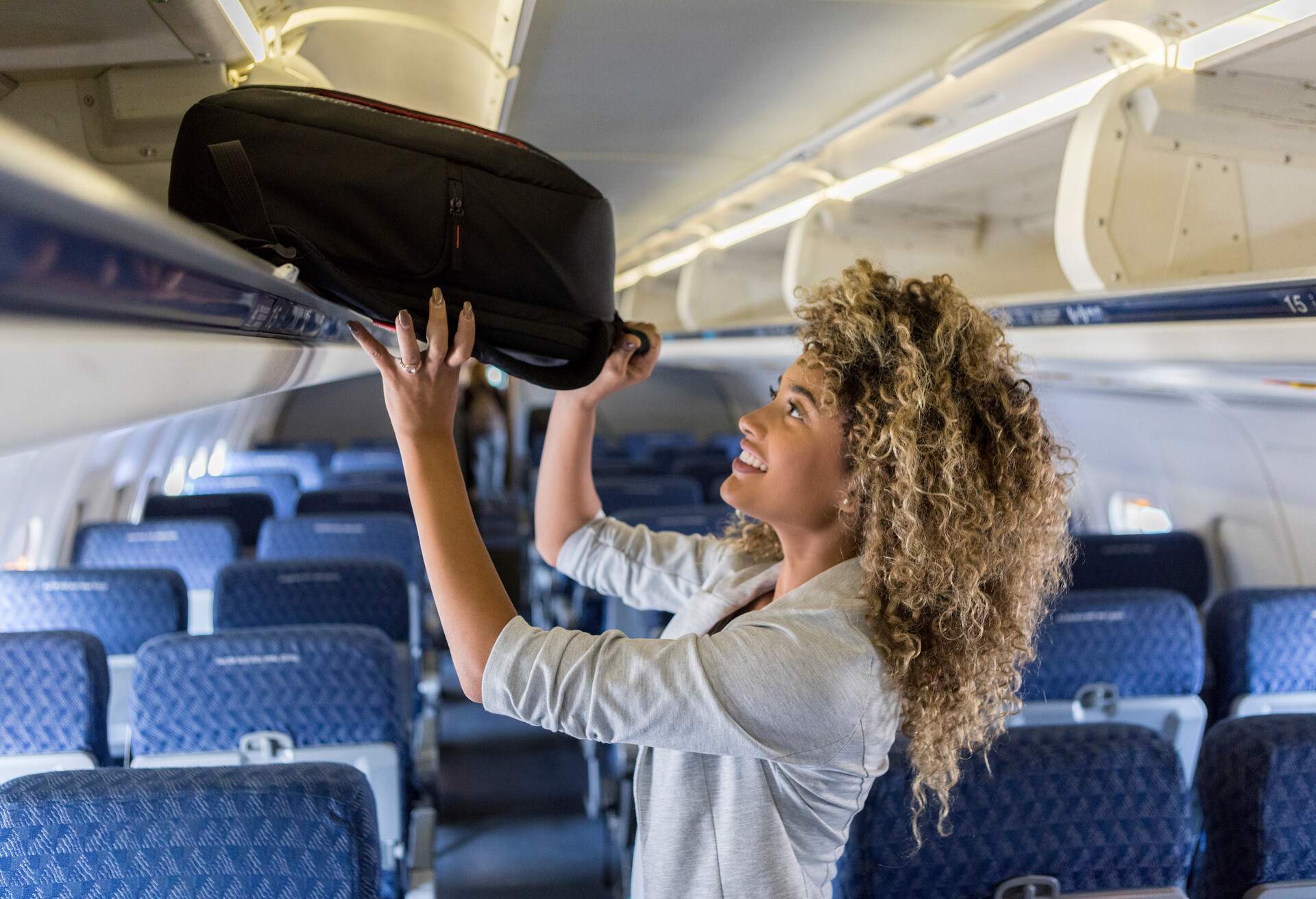
Travel right: Carry-on luggage size and weight guide

Unclear if your carry-on bag is allowed on? This article has everything you need to know to avoid last-minute encounters with TSA, excess baggage fees and a stressful start to your vacation. Use this airline-by-airline guide to see what size and how heavy your carry-on luggage can be .
In this post
- What size is carry-on luggage?
- What is the carry-on luggage weight limit?
- What is a personal item on a plane?
- What is the standard international carry-on luggage size?
- Carry-on luggage vs. a personal item: what’s the difference?
- Carry-on luggage policies for domestic airlines
- Carry-on luggage policies for international airlines
And with KAYAK’s Baggage Fee Assistant , you can see whether your luggage is included in the overall flight price. Just search for your flights on KAYAK, add the bags you want to take using the tool on the left and watch your results instantly update.
1. What size is carry-on luggage?
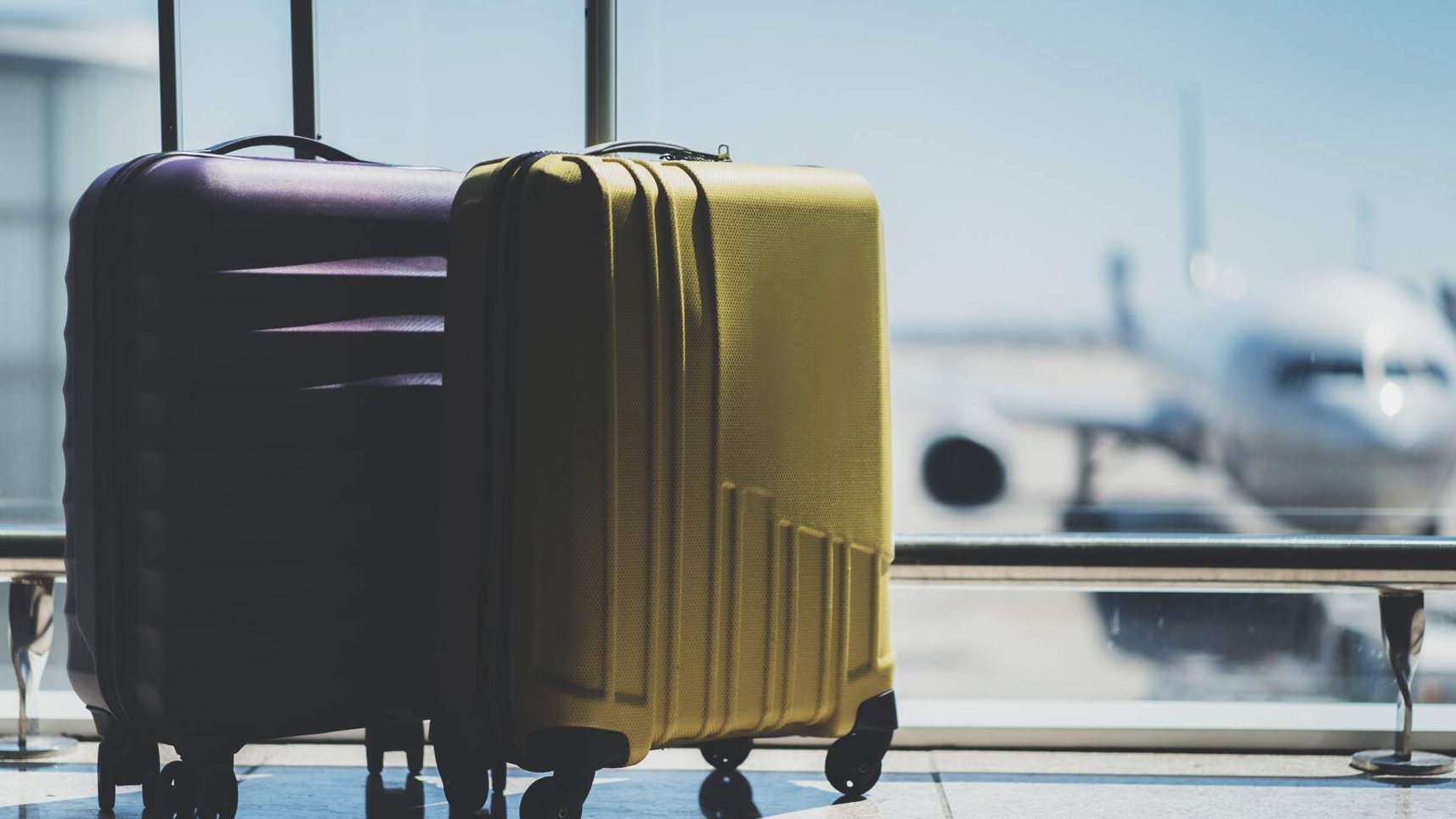
Most airlines follow very similar size regulations when it comes to carry-on luggage. The majority go by a standard height, width and depth measurement.
In general, standard domestic carry-on luggage size is 22 x 14 x 9 inches. If you’re flying internationally, that may vary a little to 21.5 x 15.5 x 9 inches. Remember, those dimensions include the handle, wheels and anything else that may protrude from your suitcase so don’t miss them from your measurements.
A few airlines, including Delta, American Airlines, Air Canada and Southwest Airlines, measure their carry-on using what’s called “linear inches”. This is a measurement that adds up the height, width and depth of your carry-on to create a single total number.
For example, Delta’s carry-on limit is 45 linear inches – so if the combined height, width and depth of your luggage is less than 45 inches, you can take it as carry-on:
✅ 22 (h) + 14 (w) + 9 (d) = 45 inches ✅ 25 (h) + 10 (W) + 10 (d) = 45 inches ❌ 24 (h) + 14 (w) + 8 (d) = 46 inches
Carry-on size limits are there to make sure everyone’s luggage will fit in the overhead bins. I always try to fly with only carry-on luggage no matter where I go or for how long. Apart from it forcing me to not overpack, I always travel easier knowing my luggage is in reach rather than in the hold, or even worse, still back at the airport!
2. What is the carry-on luggage weight limit?
Weight limits for carry-on luggage are even more of a minefield than size restrictions, although generally they’re not as strictly enforced. That doesn’t mean, however, that you can fill your case to bursting and make it so heavy it requires a group effort to get it in the overhead bin.
Many major airlines such as American Airlines, Delta, JetBlue and United Airlines have no weight limits at all. As long as you can lift your bag over your shoulders, high enough to get it in the overhead storage bin, you’re fine.
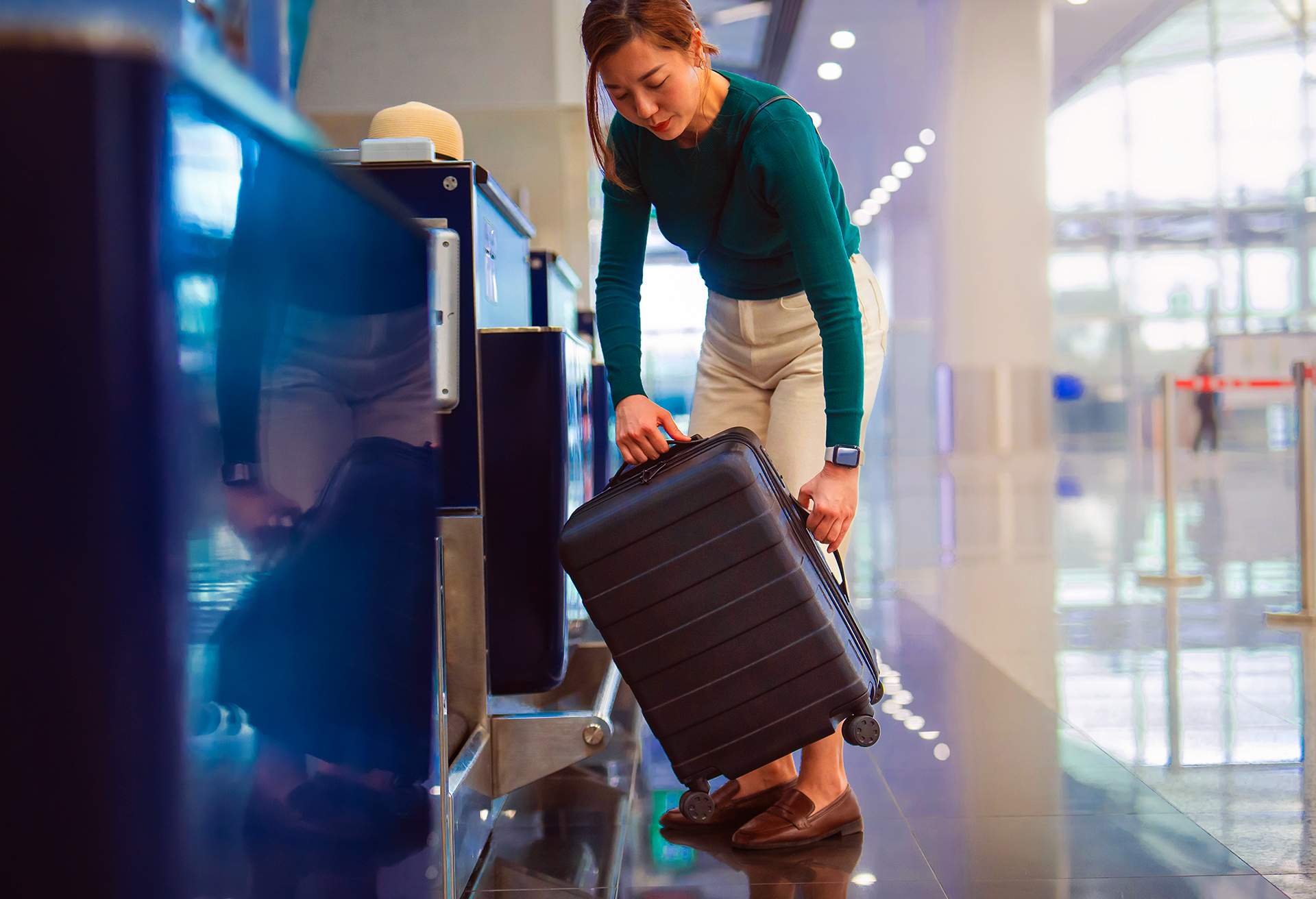
Other limits vary dramatically by airline, and can even change for the same airline depending on where you’re flying from and to. From a lightweight 15 lbs with Qantas, Qatar and Singapore Airlines to a more manageable 51 lbs with British Airways, it’s always important to check in advance.
As long as you’re sensible and within a few pounds though, you shouldn’t have any problems.

3. What is a personal item on a plane?
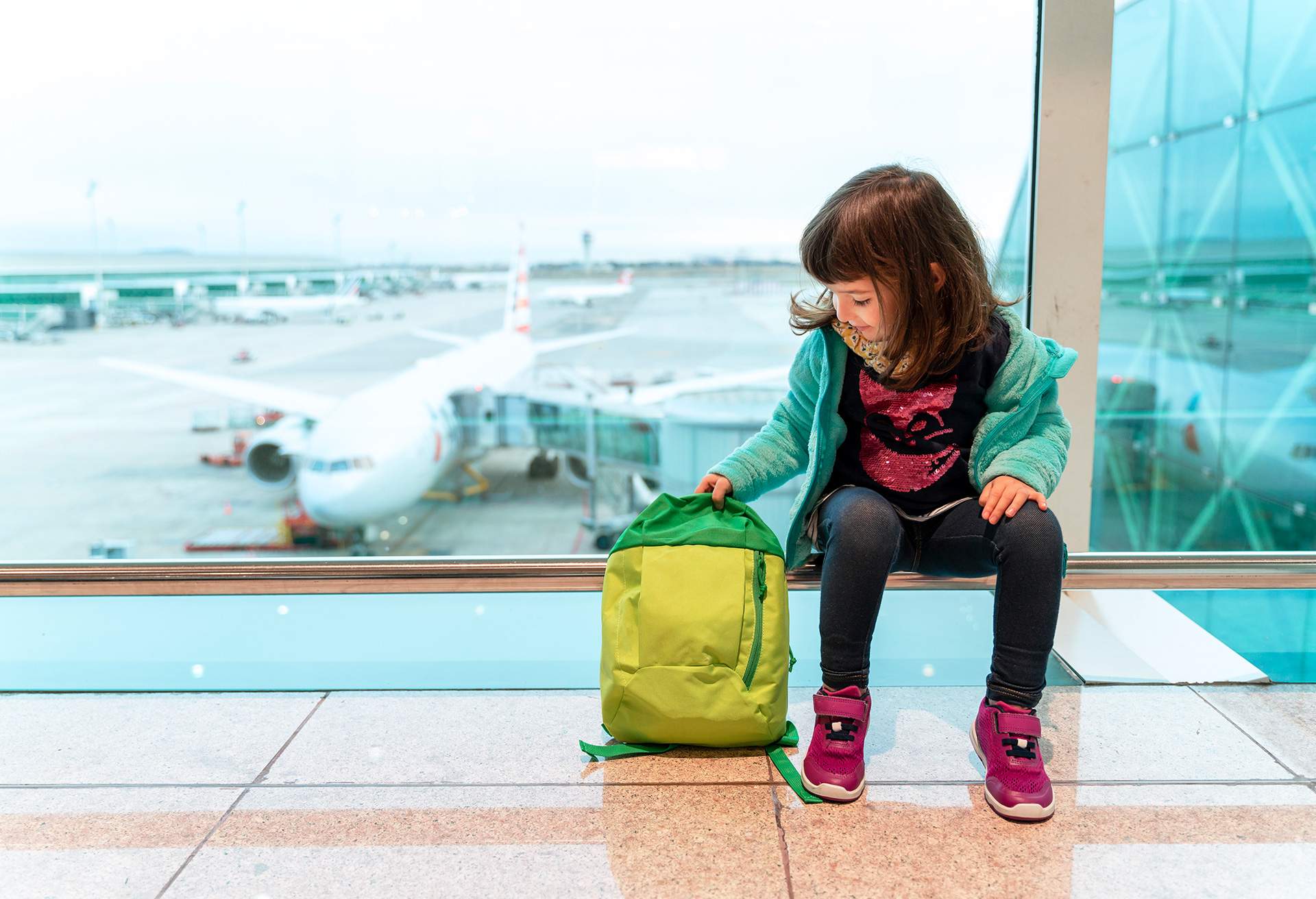
You may see some airlines include carry-on luggage and “one personal item” in their size guidelines. That personal item refers to a small bag – typically a laptop bag, purse or briefcase . Airline size regulations for personal items vary wildly, but as long as it’s small enough to fit easily under the seat in front of you, there shouldn’t be any problems.
If you have something specific to carry such as a baby bag for diapers and food, a pair of crutches or something particularly fragile, airlines tend to be quite accommodating in including it as carry-on. To be on the safe side, you should always check directly with the airline in advance.
4. What is the standard international carry-on luggage size?
Carry-on luggage sizes can vary between domestic and international flights, although not by much. For most international flights, the maximum carry-on luggage size is 21.5 x 15.5 x 9 inches or 46 linear inches . If your luggage fits within these dimensions, you’ll have no problems treating it as carry-on.
There are some exceptions such as Qatar Airways, which states measurements of 20 x 15 x 10 inches or 45 linear inches for its carry-on baggage. Pay attention in particular if you’re flying in Europe or with smaller regional airlines, as they can have very different restrictions depending on the airplane.
5. Carry-on luggage vs. a personal item: what’s the difference?
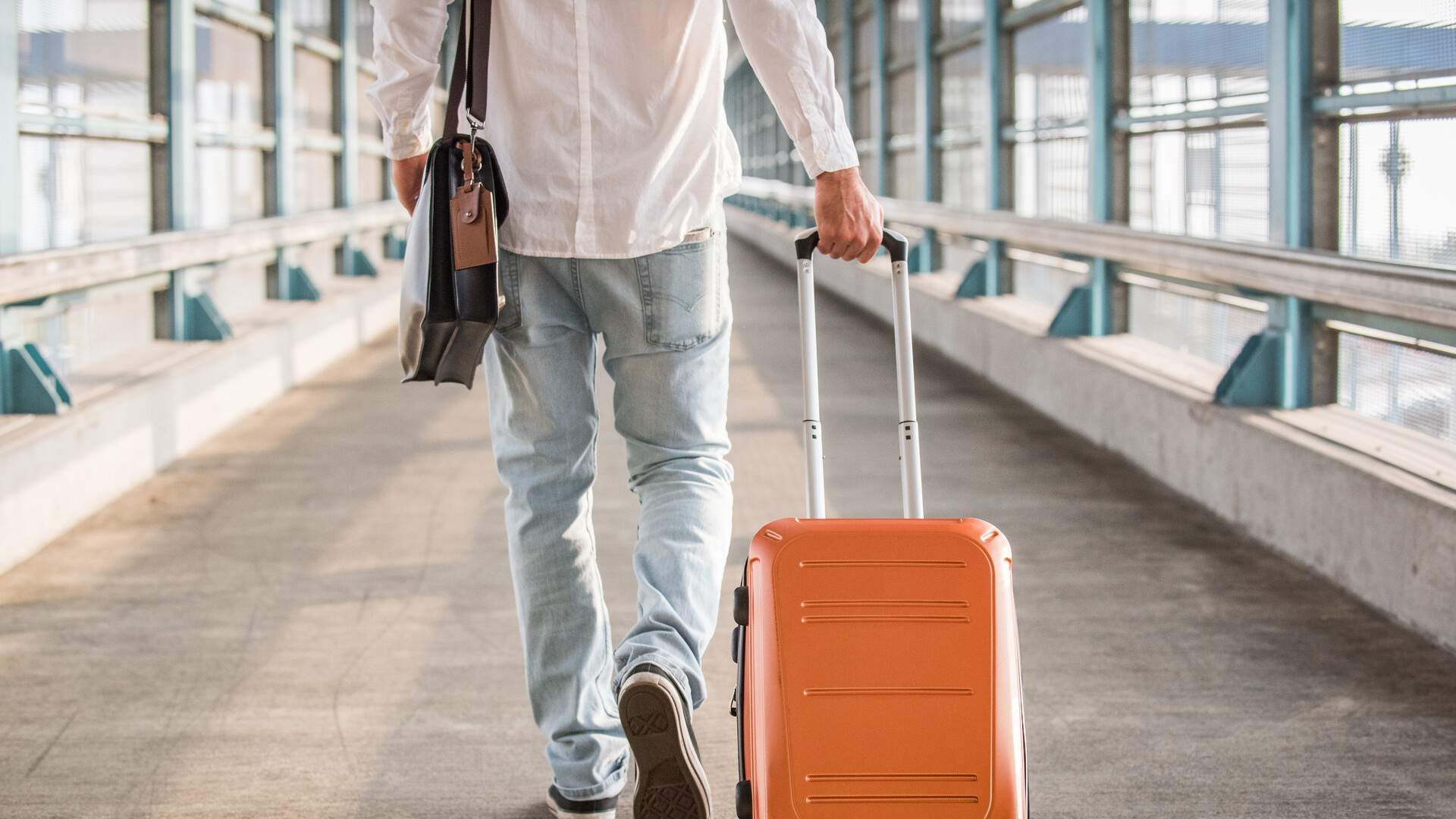
The practical difference between carry-on luggage and a personal item is that the former is for storage in the overhead bin and the latter for under the seat in front of you.
Your carry-on luggage is the bag you don’t hand over at check-in. If you’re traveling light, using your carry-on luggage allowance can prevent you having to check any bags at all. That’s always a win, as your bags will never get lost or left behind and you don’t have to wait at baggage collection once you’ve landed.
Many airlines include a carry-on luggage allowance in their ticket price. Some – especially small and budget airlines – charge extra for it, although it’s usually still cheaper than paying for checked luggage .
Personal items are things like your purse or laptop, briefcase or camera, and are usually permitted on top of your carry-on luggage free of charge. Size allowances vary by airline but most simply follow the ‘fit under the seat in front of you’ guideline.
If you’re not sure what you can take in your carry-on or personal item, check out our FAQs .
Not sure if your carry-on luggage size fits your airline policy?
To take the anxiety out of boarding and make sure your carry-on is always compliant, we created a fun Bag Measurement tool . Download the KAYAK app and you’ll never need a tape measure again.
Just open the app and tap on “Measure your bag.” Using your camera, capture your luggage and our app will do the math for you to give your bag’s exact measurements. Handily, it also compares airline baggage policies in one place too, so you can quickly check your carry-on fits no matter who you’re flying with. Watch the video below to see how it works.
6. Carry-on luggage policies for domestic airlines
Although there are differences in carry-on luggage size and weight restrictions between lots of different airlines, many also now tow a similar line to each other.
When it comes to carry-on baggage, few domestic airlines now specify a weight limit. Of those we’ve detailed below, only Hawaiian Airlines and Frontier Airlines impose weight restrictions. The rest go by dimensions only.
For personal items, Delta, Alaska and Hawaiian Airlines all dispense with measurements, instead simply asking that it fits under the seat in front of you. None of the domestic airlines impose a weight limit.
To make it easier for you to search, we’ve gone through the main domestic US airlines and detailed the size and weight limits for both carry-on luggage and personal items. We’ve also included any other relevant information, tools and tips we think you might find useful when flying with each specific airline.
Alaska Airlines
American Airl ines
Hawaiian Airlines
Southwest airlines, spirit airlines, united airlines.
- Carry-on luggage size: 22 x 14 x 9 inches
- Carry-on luggage maximum weight: Not specified
- Personal item size: Must fit under the seat in front of you
- Personal item maximum weight: Not specified
The Alaska Airlines carry-on luggage allowance includes one carry-on bag and one personal item for all fares.
American Airlines
- Personal item size: 18 x 4 x 8 inches
The American Airlines carry-on luggage allowance includes one carry-on bag and one personal item for all fares, Basic Economy included.
- Carry-on luggage size: 22 x 14 x 9 inches or 45 linear inches
- Carry-on luggage maximum weight: None (with exceptions)
- Personal item size: Must fit under the seat in front of you
- Personal item maximum weight: Not specified
All Delta fares include one carry-on bag and one personal item. Most routes have no weight limit for carry-on with a few exceptions. Flying to or from Beijing or Shanghai in China comes with a 22lb weight limit, and from Singapore it’s a 15lb limit.
- Carry-on luggage size: 24 x 10 x 16 inches
- Carry-on luggage maximum weight: 35 lbs
- Personal item size: 14 x 18 x 8 inches
Frontier fares include only a personal item and no carry-on luggage. That means you’ll need to add and pay for carry-on luggage, with prices varying by route and when you add it. As always, adding it when you book your flights will be cheapest.
As always, there are exceptions. If you buy one of the WORKS or PERKS fare bundles, carry-on (as well as checked) baggage is included. And if you’re an Elite member of the FRONTIER Miles rewards program you too are blessed with carry-on included.
- Carry-on luggage size: 22 x 14 x 9 inches
- Carry-on luggage maximum weight: 25 lbs
Hawaiian Airlines includes carry-on luggage and a personal item on all fares, but watch out for that weight limit.
- Carry-on luggage maximum weight: None
- Personal item size: 17 x 13 x 8 inches
You can take a carry-on bag and personal item on all fares except a Blue Basic ticket, where you can only bring a personal item – most of the time. There are, of course, some exceptions.
If you’re in the US military, are an unaccompanied minor, or are traveling to or from the UK or Europe, including connecting flights , you can take carry-on with a Basic Blue fare . The same applies if you upgrade your seat or reach the giddy heights of Mosaic status in JetBlue’s TrueBlue rewards program.
- Carry-on luggage size: 24 x 16 x 10 inches
- Carry-on luggage maximum weight: Not specified
- Personal item size: 16.25 x 13.5 x 8 inches
Note: As well as offering comparatively generous carry-on and personal item sizes, Southwest also includes both in all its fares.
- Carry-on luggage size: 22 x 18 x 9 inches
- Personal item size: 18 x 14 x 8 inches
- Personal item maximum weight: None
Spirit keeps its flight prices low by charging for carry-on baggage and allowing only a smaller personal item for free. Fees vary depending on the route and when you buy it.
If you add when booking your flight, the average fee is $37, although that can be lower for domestic US flights. Add it later and it gets more expensive the longer you leave it, rising to $65 if you pay at the gate. The moral being, always add luggage when you book to get the best deal.
- Personal item size: 17 x 10 x 9 inches
If you’re flying domestically or between the US and Canada, you can bring one carry-on bag and one personal item on all fares except Basic Economy, where you can only bring a personal item.
If you’re flying to South America or across the Atlantic or Pacific on a Basic Economy fare, you can bring carry-on luggage and a personal item.
Certain MileagePlus, Premier and Star Alliance Gold members also qualify to bring a carry-on to all flights no matter their fare. Check the United carry-on guide for details.
7. Carry-on luggage policies for international airlines
Many of the international airlines have different fares and a confusing array of classes, from economy to first. These come with different carry-on and personal item restrictions, so be sure to check which class ticket you have before packing.
Aer Lingus, Air Canada, Lufthansa, Scandinavian Airlines (SAS) and Turkish Airlines all have the same carry-on size limit but weight allowances vary. Almost all of the International airlines we’ve listed impose carry-on weight restrictions, and many on personal items as well. The only exception is Air Canada.
British Airways
Qatar airways, scandinavian airlines (sas), turkish airlines.
- Carry-on luggage size: 21.5 x 15.5 x 9.5 inches
- Carry-on luggage maximum weight: 22 lbs
- Personal item size: 13 x 10 x 8 inches
Aer Lingus has gone to town on the complexity of its carry-on policies and prices.
If you’re flying trans-Atlantic, your carry-on and personal item are included in your fare. If you’re flying in Europe, you’ll need to book a “Carry-on bag with priority boarding” ticket and pay upwards of €9.99. Or you can check your bag into the hold, in which case it’s free.
There are a raft of exceptions to this including different fare types and connections, so you should check carefully when you book.
If you’re flying Aer Lingus Regional (that uses smaller planes limited mostly to Ireland and the UK), the allowances shrink. Your carry-on must be a maximum of 18.5 x 13 x 8 inches and weigh no more than 15 lbs.
Air Canada lets you bring a carry-on bag and personal item on all its fares, but does stress that you must be able to lift your carry-on into the overhead bin unassisted.
- Carry-on luggage size: 21.6 x 13.7 x 9.8 inches
- Carry-on luggage maximum weight: 26.4 to 40 lbs (fare dependent) including personal item
- Personal item size: 15.7 x 11.8 x 5.8 inches
- Personal item maximum weight: 26.4 to 40 lbs (fare dependent) including carry-on luggage
If you’re traveling with Air France on an Economy ticket, you can take one carry-on and a personal item with a combined weight of 26.4 lbs. If you’re flying in Premium Economy, Business, or La Première, you can take two carry-on bags and one personal item with a combined weight of 40 lbs. Air Canada lets you bring a carry-on bag and personal item on all its fares but does stress that you must be able to lift your carry-on into the overhead bin unassisted.
- Carry-on luggage size: 22 x 18 x 10 inches
- Carry-on luggage maximum weight: 51 lbs
- Personal item size: 16 x 12 x 6 inches
- Personal item maximum weight: 51 lbs
British Airways includes a carry-on bag and personal item in all its fare prices, with generous size allowances.
- Carry-on luggage size: 22 x 17.5 x 9.5 inches
- Carry-on luggage maximum weight: 33 lbs
- Personal item size: 17.5 x 14 x 8 inches
- Personal item maximum weight: 33 lbs
Another of Europe’s huge budget airlines, easyJet offers only a personal item to take free on board, which they market as a “small cabin bag.” For a proper size carry-on bag you’ll need to book a FLEXI Fare or an Up Front or Extra Legroom seat, or just add a large cabin bag separately. Prices start from £5.99.
- Carry-on luggage size: 22 x 15 x 8 inches
- Carry-on luggage maximum weight: 15 to 30 lbs (fare dependent)
- Personal item size: 22 x 15 x 8 inches
- Personal item maximum weight: 15 lbs
Economy class passengers can bring a single carry-on weighing 15 lbs. Premium Economy passengers can up that to 22 lbs. Business and First Class can bring two carry-ons of up to 15 lbs each. As with Qatar Airways, tickets issued in Brazil have a weight limit of 22 lbs.
Beware too that Emirates only allows one item for Economy and Premium Economy fares – either a carry-on or a personal item, not both. It also notes that if you carry a garment bag it must be no more than eight inches thick when folded.
- Carry-on luggage size: 21.5 x 13.5 x 9.5 inches
- Carry-on luggage maximum weight: 26 to 40 lbs (fare dependent) including personal item
- Personal item maximum weight: 26 to 40 lbs (fare dependent) including carry-on luggage
KLM’s policies change with their fares. Economy gets one carry-on and one personal item up to 26 lbs in combined weight. Premium Comfort gets two carry-ons and a personal item but the same combined weight of 26 lbs. Business Class gets the same as Premium Comfort but with a weight increase to 40 lbs.
And if you bring a baby on your lap, you can take one extra carry-on weighing up to 26 lbs.
- Carry-on luggage size: 21.5 x 15.5 x 9 inches or 22.5 x 21 x 6 inches for foldable garment bags
- Carry-on luggage maximum weight: 17.5 lbs
- Personal item size: 15.5 x 11.5 x 4 inches
All Lufthansa Economy Class and Premium Economy Class fares include one carry-on bag and personal item, with size and weight restrictions. Business and First Class fares include two carry-on bags, although the second bag may need to be checked in on flights from Italy, India and the USA.
- Carry-on luggage size: 20 x 15 x 10 inches
- Carry-on luggage maximum weight: 15 to 33 lbs (fare dependent)
- Personal item size: Not specified
Economy Class Qatar Airways passengers can take one carry-on and one personal item weighing up to 15 lbs. Business and First class can take two carry-on bags and one personal item weighing up to 33 lbs. Tickets issued in Brazil have a weight limit of 22 lbs.
It’s worth noting that Qatar Airlines considers your laptop and case part of your carry-on and not a personal item. Note too that 20 inch luggage length is shorter than most other carriers.
- Carry-on luggage size: 21.5 x 15.5 x 8 inches
- (Priority fares) Carry-on luggage maximum weight: 22 lbs
- (Priority fares) Personal item size: 15.5 x 8 x 10 inches
Budget airline Ryanair keeps its prices low by allowing only a smaller personal item as part of the fare price. You’ll need to buy its Priority & 2 Cabin Bags option if you want to take a carry-on bag weighing up to 22 lbs. Prices vary by route and when you book.
Ryanair’s Priority bundle also lets you board the plane early, but don’t be fooled! This often means standing at the front of the queue in a corridor instead of relaxing at the gate while waiting for the plane to be ready.
- Carry-on luggage size: 21.5 x 15.5 x 9 inches
All SAS fares allow you to take one carry-on bag and a personal item with the exception of the Go Light fare – but only if you’re traveling in Europe. On this fare you’ll need to pay for your carry-on bag. If you’re on a Go Light fare to or from Asia, Canada or the US, your carry-on is included.
Plus and Business Class passengers can take two carry-on bags with them. SAS also notes you can bring airport purchases and Duty Free bags onboard with you at no cost.
- Personal item size: 15.5 x 11.5 x 6 inches
- Personal item maximum weight: 9 lbs
Turkish Airlines Economy Class passengers can take one carry-on and one personal item on board. Business Class passengers can take one extra carry-on of the same weight and dimensions.
For both domestic and international flights, infant passengers are also allowed one more carry-on bag.
- Personal item size: 16 x 12 x 8 inches
All fares can take a personal item on board , but you can only take a carry-on bag if you’re on a TimeFlex Fare, are a Premium customer, require assistance at the airport or are traveling with a child younger than two.
How was this guide created?
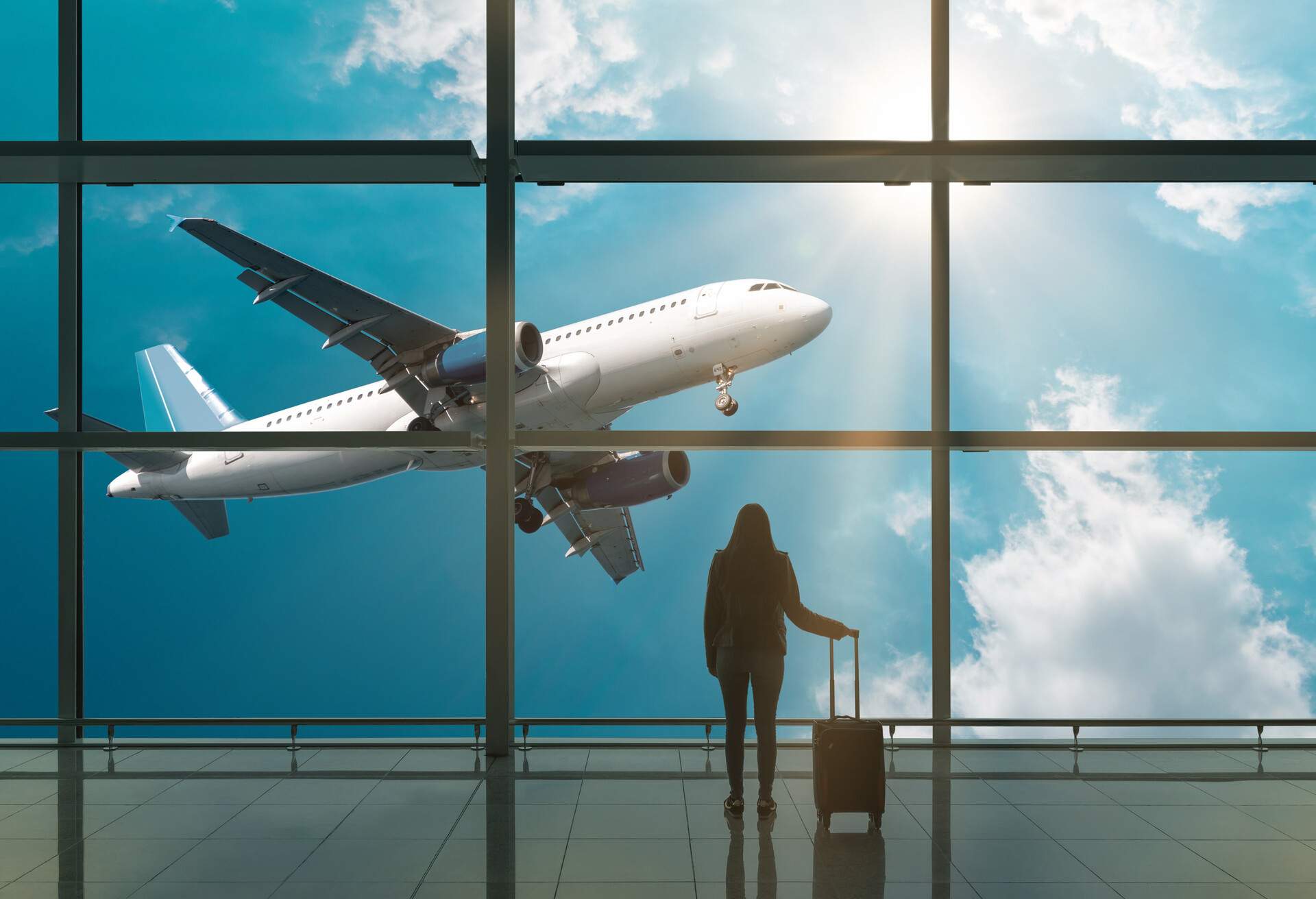
Experience and research! I’ve been traveling the world and writing stories about it for 20 years and have one mantra: carry-on is king. Unless I’m nervously checking in surfboards or skis, I only ever pack a carry-on and personal item.
Over time I’ve learned a lot about the tricks to success and pitfalls of getting carry-on wrong. This guide is a culmination of that experience combined with extensive research into US and international airline luggage policies. I also got great advice from the KAYAK teams who build the features and tools you use to book your travel.
If you found this article helpful, we’ve got plenty more inspiration and information to share. Unsure where to travel this year? Check out our guide to traveling with a carry-on vs checked bag and if you’re thinking of traveling off-season, this in-betweasons guide has an in-depth breakdown of prices and places to visit. Dive in!
This post is part of our Flight guide. Want to make sure you get the most out of your trip? Read about how to find cheap flights in our guide.
Carry-on luggage FAQs
A backpack is generally considered a personal item rather than a carry-on, as long as it fits below the seat in front of you or meets the dimensions specified by the airline.
If you’re traveling with a full size backpack that can only be stored in the overhead bins, this would qualify as carry-on luggage. As always, check the permitted dimensions and weight before you travel.
A duffel bag is typically considered carry-on luggage, yes. This does, of course, depend on its dimensions which are almost always the deciding factor for airlines over the type of luggage you have.
If it’s too big to fit under the seat in front of you and has to go in the overhead bin, you should consider it to be carry-on luggage rather than a personal item.
None of the international airlines we’ve mentioned in this guide would allow a 24-inch suitcase as carry-on, as it doesn’t meet their size requirements. Domestically, both Frontier and Southwest Airlines would allow you to take your 24-inch suitcase as carry-on thanks to their generous size limits.
Generally, I’d say a 24-inch bag will be treated as check-in luggage more often than carry-on, so think carefully before traveling with it!
The TSA has strict rules around what you can take in your carry-on luggage. Generally speaking you can take most things you’ll need for your journey.
Foods including fruits are fine. If you’re taking baby foods and medicines it’s worth checking with the airline first to make sure they don’t breach liquid limits. If you have support devices like crutches, walking stick, stroller or wheelchair, you shouldn’t have any problems but let the airline know in advance, just to be sure.
The TSA has strict rules around what you can’t take in your carry-on luggage . Rules against carrying weapons and ammunition are obvious, but it’s liquid allowances that catch most people out.
Currently, you can’t bring any liquid, gel, aerosol, cream or paste containers bigger than 3.4 ounces (100ml if you’re in Europe). If you do, it’ll be confiscated at security or you’ll be turned away if you’re not willing to relinquish it. Exceptions include medications and children’s foods but it’s always worth checking in advance to be sure.
Disclaimer: prices and information are correct as of 21.07.2023 and may vary with time.
About the author

Explore more articles
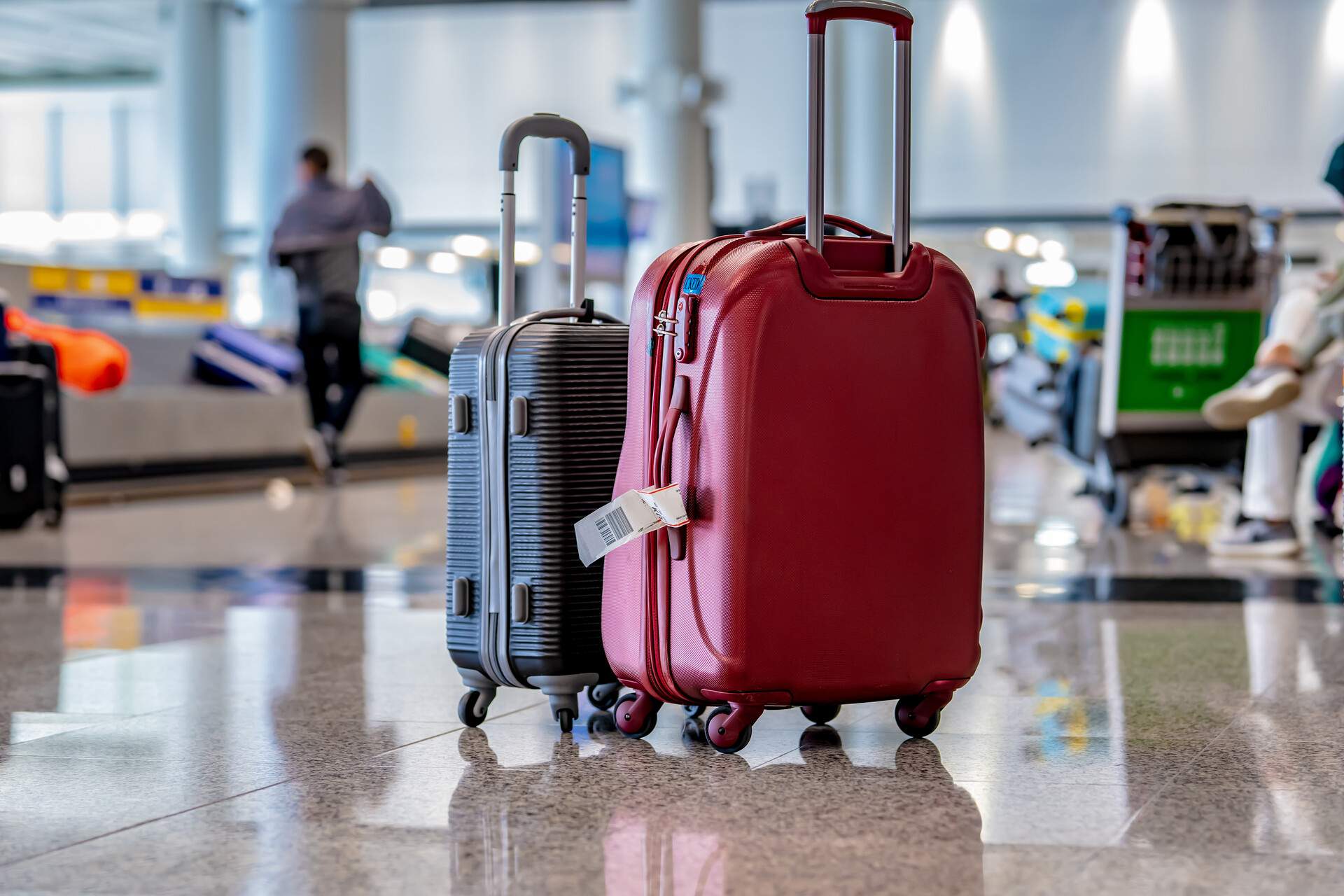
California consumers have the right to opt out of the sale * of their personal information. For more information on how we securely process personal information, please see our Privacy Policy .
Do not sell my info ON
* The definition of "sale" under the California Consumer Privacy Act is applicable only to California consumers.
Protect Your Trip »
Carry-on luggage size and weight limits by airline (2024).
Just like checked bags, carry-on luggage size restrictions can vary by airline.
Carry-on Luggage Sizes by Airline

Key Takeaways
- The carry-on size limit for many airlines is 22 x 14 x 9 inches.
- Most domestic airlines do not have a weight limit for carry-on bags.
- You can typically bring a carry-on bag in addition to a personal item.
- Your personal item should be able to fit neatly under the seat in front of you.
If you're traveling with carry-on luggage and/or a personal item , you'll need to adhere to size restrictions in the same way you do with checked bags . These rules include the dimensions of your carry-on bag and, in some scenarios, even the weight.
What size luggage is a carry-on?
While carry-on luggage sizes can vary by airline, several major carriers go by these dimensions.
Airlines calculate carry-on luggage size measurements using two methods:
- Height by width by depth: Most – but not all – airlines measure bags by inches or centimeters using this formula: height by width by depth, such as 22 x 14 x 9 inches. (Note: The dimensions listed below, which are given according to that formula, may differ slightly from the way each individual airline formats its size requirements.)
- Linear inches: A few airlines have linear inch restrictions for carry-on baggage, meaning the airline gives one number for the total of all three dimensions. As long as the combined height, width and depth don't exceed that number, you're in the clear.
Can a 24-inch bag be a carry-on?
Yes, a 24-inch bag can be used as a carry-on suitcase when flying with the following airlines: Frontier, Southwest and Sun Country . However, if you're shopping for new carry-on luggage, it's best to opt for something that meets the requirements for most major airlines (22 x 14 x 9 inches or smaller).
Is there a weight limit for carry-on bags?
Most major domestic airlines do not impose a weight limit on carry-on bags; however, several international airlines have weight restrictions for carry-on luggage and, in some cases, personal items.
Carry-on vs. personal item: What's the difference?
A carry-on bag is typically stored in a plane's overhead bin, while a personal item should fit under the seat in front of you. Most airlines allow economy passengers to bring one carry-on and one personal item – such as an underseat bag – at no extra cost.
Carry-on luggage sizes by airline
Click on the major domestic and international airlines below to see their carry-on luggage size restrictions in inches for economy passengers – and note that any handles and wheels on your bags count toward size limits as well.
Domestic Airlines
Alaska airlines, allegiant air, american airlines, delta air lines, frontier airlines, hawaiian airlines, southwest airlines, spirit airlines, sun country airlines, united airlines, international airlines, all nippon airways, british airways, cathay pacific, klm royal dutch airlines, qatar airways, scandinavian airlines, singapore airlines, turkish airlines, virgin atlantic.
See all Alaska Airlines carry-on policies.
The fee is often around $20 if you pay for your carry-on baggage at the time of booking; it costs a hefty $45 if you add a carry-on bag later – and up to $75 at the gate.
See all Allegiant Air carry-on policies.
The above rules also apply to basic economy tickets.
See all American Airlines carry-on policies.
Note that if you're flying to or from Beijing or Shanghai, there is a 22-pound weight limit for a carry-on; for Singapore, there is a 15-pound limit.
See all Delta Airlines carry-on policies.
There are two instances where the carry-on bag fee is waived:
- You're an elite member of the FRONTIER Miles rewards program .
- You bought a specialty ticket like the WORKS bundle.
Also note that carry-on bag fees, which typically start at around $30, depend on your destination, and that prices are cheapest if you add baggage when you make your booking. You'll pay more to add it later, especially if you do so at the airport. Sometimes it's actually cheaper to purchase a checked bag instead of a carry-on.
See all Frontier Airlines carry-on policies.
See all Hawaiian Airlines carry-on policies.
If you booked a Blue Basic ticket, you're only permitted to bring a personal item that fits under the seat in front of you. If you bring a carry-on bag, you must pay $65 to check it at the gate (or up to $180 if you've already checked two other bags). This will change on Sept. 6, 2024, when JetBlue will begin offering one free carry-on bag to all Blue Basic customers, regardless of purchase date.
Currently, select customers with Blue Basic fares can bring carry-on bags for free. These include:
- Active U.S. military personnel
- Unaccompanied minors
- Customers flying to London
If you purchase a higher-class seat or if you reach Mosaic status on JetBlue's TrueBlue rewards program , you can also bring a carry-on bag for free on a Blue Basic ticket.
See all JetBlue carry-on policies.
See all Southwest Airlines carry-on policies.
Spirit's carry-on bag fees vary between flights, but they tend to start at around $25 to $30 for U.S. domestic flights. If you need to bring carry-on luggage, it's always cheapest to pay for it when you first book your flight. It will cost you more to add a bag afterward – and at least double the initial fee if you do it at the airport.
See all Spirit Airlines carry-on policies.
The Sun Country Airlines fee for a carry-on bag is around $30 if you pay for it when booking, or more if you add it later.
See all Sun Country carry-on policies.
There's one notable exception for carry-on baggage with United: Passengers with a basic economy ticket can only take one personal item on board – no carry-on bag. This policy applies to travelers flying basic economy domestically or between the U.S. and Canada. If you have a basic economy ticket and are going to Central or South America (including Mexico) or taking trans-Atlantic or trans-Pacific flights, you can bring a full-size carry-on bag.
See all United Airlines carry-on policies.
Aer Lingus' carry-on policy depends on where you're flying. For trans-Atlantic flights, you can bring one carry-on bag within the dimensions above, plus a small personal item for free. If you're flying within Europe on Aer Lingus, the rules are a bit different: You'll have to pay a fee to bring a carry-on with you on board, starting at 5.99 euros. However, you can check that same bag for free.
If you're flying Aer Lingus Regional (a service with smaller planes, flying mostly around Ireland and the U.K.), a smaller carry-on limit applies: 18.5 x 13 x 8 inches, with a weight limit of 15 pounds.
See all Aer Lingus carry-on policies.
All Aeroméxico customers can bring a standard carry-on bag and a personal item on board. Be careful with the weight limit, though: For international flights or basic fare flights within Mexico, these two items combined cannot weigh more than 22 pounds. So, if your carry-on bag weighs 15 pounds, for example, your personal item cannot be more than 7 pounds.
See all Aeroméxico carry-on policies.
While there's no weight limit for carry-on luggage, Air Canada says your carry-on bag should be light enough that it can easily be lifted into the overhead bin. Also note that airport purchases (for example, larger duty-free items) count toward your baggage limit.
See all Air Canada carry-on policies.
Note that both your personal item and carry-on bag (referred to as "hand baggage") combined must not weigh more than 26 pounds if you're traveling economy. The weight limit is 40 pounds for premium economy and other higher-class cabins.
See all Air France carry-on policies.
A variety of personal items (think a handbag and umbrella) are permitted as long as they fit under the seat in front of you; this includes any items purchased at the airport.
See all All Nippon Airways carry-on policies.
If airline staff put a yellow tag on your bag, it should be stored under the seat in front of you.
See all British Airways carry-on policies.
Cathay Pacific has shifted from a weight allowance to a piece allowance, and this policy varies by itinerary. Passengers are generally permitted to bring one carry-on bag plus a small personal item (and assistive devices like a walking stick), but it's best to check your booking carefully to confirm the exact allowance. You're asked to check in any baggage that's too heavy to lift into the overhead compartment.
See all Cathay Pacific carry-on policies.
Since easyJet is a budget airline, standard fares only allow customers to bring one personal item (called a "small cabin bag") aboard for free. Fees for standard carry-on bags are between 5.99 and 32.99 British pounds, depending on your destination and when you add an extra bag to your reservation.
See all easyJet carry-on policies.
The above rules apply to all economy passengers except those traveling from Brazil, whose carry-on luggage can weigh up to 22 pounds. Emirates only allows economy passengers to bring one item on board; whether you bring a carry-on bag for the overhead bin or a personal item to tuck under the seat, this bag must comply with the size limits.
See all Emirates carry-on policies.
Be aware that the 22-pound weight limit applies to both your personal item and carry-on combined. If your flight was booked through Iberia but is operated by Vueling, similar rules apply, but the size limits for your carry-on bags are slightly smaller.
See all Iberia carry-on policies.
If you're traveling on the cheaper Light ticket, you may be asked to check your carry-on bag for no extra cost, if space is limited.
See all KLM Royal Dutch Airlines carry-on policies.
See all Lufthansa carry-on policies.
The above rules apply to LowFare+ customers. Passengers who fly LowFare (comparable to Basic Economy fare) can only bring a personal item (underseat bag) measuring 15 x 11.5 x 7.5 inches.
See all Norwegian carry-on policies.
Qantas
Economy passengers can opt to bring a nonrigid garment bag measuring 45 x 24 x 4 inches (or 73 linear inches) instead of a standard 22 x 14 x 9-inch carry-on bag. The above rules apply to all economy tickets and vary for higher classes on international and domestic flights with Qantas.
See all Qantas carry-on luggage policies.
Qatar Airways allows passengers to bring multiple personal items provided they fit under the seat in front of you. Unlike with other airlines, laptops and laptop bags do not count as personal items and must fit within your main hand baggage allowance. For tickets issued in Brazil, the carry-on weight limit is 22 pounds.
Be careful: Qatar doesn't accept carry-ons longer than 20 inches, which is shorter than many other airlines.
See all Qatar Airways carry-on policies.
Ryanair is a low-cost carrier, so unless you pay extra, you can only bring one small bag that fits under the seat in front of you, per the personal item guidelines above. To bring a larger carry-on bag, travelers need to purchase Ryanair's Priority & 2 Cabin Bags option, which typically costs between 6 and 32 euros depending on your destination.
See all Ryanair carry-on policies.
Tips on Trips and Expert Picks Newsletter
Travel tips, vacation ideas and more to make your next vacation stellar.
Sign up to receive the latest updates from U.S News & World Report and our trusted partners and sponsors. By clicking submit, you are agreeing to our Terms and Conditions & Privacy Policy .
Most (but not all) Scandinavian Airlines fares allow you to bring one traditional carry-on bag, plus a personal item, which SAS calls an "underseat bag." There's one exception: Passengers traveling within Europe on the Go Light fare must pay for a larger carry-on bag. If you booked a Go Light ticket for intercontinental flights, a carry-on bag is included.
See all Scandinavian Airlines carry-on policies.
Singapore Airlines has an unusual method for measuring carry-on bags – the dimensions of the bag must not add up to more than 45 linear inches total. For example, a bag measuring 15 x 15 x 15 inches would be suitable. All passengers can bring one bag of this size, plus a smaller personal item. The personal item, whose dimensions are specified above, does not count toward the 15-pound carry-on limit.
See all Singapore Airlines carry-on policies.
See all Turkish Airlines carry-on policies.
Virgin Atlantic lets every passenger bring a carry-on bag, including children younger than age 2. You can bring a bag weighing no more than 13 pounds for your child, in addition to a collapsible stroller and/or car seat. Each passenger is also allowed to bring a handbag or small backpack, an umbrella, a walking stick and airport purchases. Take note: Laptops do not count as personal items on Virgin Atlantic and should fit into your main carry-on bag. There's no specific size limit on the other personal items, but bags or airport purchases should fit under the seat in front of you.
See all Virgin Atlantic carry-on policies.
Note that the above rules apply to passengers who book a TimeFlex or Premium Fare, as well as anyone traveling with a child under age 2 and/or requiring special assistance at the airport.
See all Vueling carry-on policies.
If you purchase an UltraBasic fare, you are limited to a personal item that fits under the seat in front of you.
See all WestJet carry-on policies.
Why Trust U.S. News Travel
Amanda Norcross is a seasoned traveler who packs just one carry-on bag and a personal item – even when adventuring with her toddler . She used her personal experience and research skills to put together this guide, and notes that even if your carry-on bag meets size restrictions, you may still need to check it at the gate because of limited space in the overhead bin. Luckily, it's still free.
You might also be interested in:
- The Best Carry-on Backpacks
- What Is Allowed in a Carry-on?
- What to Pack in a Carry-on Bag
- The Best Travel Insurance Companies
Tags: Travel , Airlines , Travel Tips
World's Best Places To Visit
- # 1 South Island, New Zealand
- # 4 Bora Bora
If you make a purchase from our site, we may earn a commission. This does not affect the quality or independence of our editorial content.
You May Also Like
Top music-themed cruises.
Gwen Pratesi Aug. 23, 2024

The Best Rome Tours
Kyle McCarthy and Ann Henson Aug. 23, 2024

The Best Kids Sail Free Cruises
Holly Johnson Aug. 21, 2024

7 Best San Francisco Wine Tours
John Rodwan and Marisa Méndez Aug. 20, 2024

The Best Weekend Getaways From LA
Sharael Kolberg Aug. 20, 2024

The 6 Best Chicago Walking Tours
Holly Johnson Aug. 20, 2024

The 9 Best Mexico City Tours
Gwen Pratesi Aug. 20, 2024

Best Horseback Riding in Estes Park
Gwen Pratesi Aug. 19, 2024

The Best College Town Hotels
Rachael Hood Aug. 19, 2024

The Best Rome Colosseum Tours
Laura Itzkowitz Aug. 19, 2024

Your cart is empty
SHOP BY CATEGORY

CARRY-ON LUGGAGE

CHECKED LUGGAGE
- Aviation Professionals
Guide to International Carry-On & Luggage Standards

International flights differ significantly from domestic flights. For one thing, while you can often travel with only a carry-on domestically, most travelers require at least two pieces of luggage for international travel. Individual airline policies determine fees for international luggage, your international flight baggage allowance, and the luggage weight limit for international flights. Your destination and origin point also play a role in determining baggage allowance and fees, as does your frequent flier status and whether you’re flying first class, business, or economy.
A general overview of how airlines handle luggage for international flights follows. Before you travel, it’s best to contact your airline and confirm their luggage policies, as airline regulations for luggage change frequently.
Luggage Weight Limits
The luggage weight limit for international flights differs from domestic US weight limits, which can become a problem if you need to switch between domestic and international flights to reach your destination. Check airline regulations carefully, and pack with the lowest weight allowance for your carry-on and checked luggage for all flights.
Carry-on Weight Limits
Carry-on baggage weight limits for international travel differ significantly from domestic carry-on rules. Most domestic flights limit carry-on suitcases , bags, and backpacks to 35 lbs.
The allowable weight of carry-on luggage differs from airline to airline, but your carry-on luggage generally cannot weigh more than 16 to 18 lbs for international flights. British Airways is an exception and sets its carry-on weight limit at a whopping 51 lbs.
Checked Bags
The checked luggage weight limit for international flights is usually the same as for domestic flights: 50 lbs. Most airlines set 50 lbs as their weight limit to reduce the risk of injury to baggage handlers.
As with carry-on luggage, there are exceptions to checked luggage weight limits. International flights in the US and European Union set a maximum weight of 70 lbs for checked luggage, although you may have to pay fees if you exceed the 50 lb limit guideline. Individual airlines can also set lower weight allowances for international checked luggage. Once again, check with all airlines on your flight itinerary to verify their luggage weight limits.
International Suitcase Sizes
International luggage sizes are just as important as weight limits when choosing your travel luggage. Size restrictions for international airlines may be expressed in inches or centimeters by height, width, and depth. Alternately, all three measurements are added together to equal a single dimension expressed in linear inches or centimeters. Be aware that most airlines outside of the US will measure bags in centimeters.
Personal Items
Many international airlines don’t have exact size restrictions for personal items. But the most common size limit is 40 inches (102cm) (length, plus width, plus height) or 18 x 14 x 8in (46 x 36 x 20cm). If it can safely fit under the seat in front of you or in the seat back pocket without being a hazard, it’s considered the appropriate size.
This will, however, vary depending on the airline. Smaller planes won’t have as much room under the seats as larger planes. Of course, double-check your chosen airline before you go.
International Carry on
Carry ons for international flights are usually a maximum of 22 inches (55cm) tall, 15 inches (40cm) wide, and 10 inches (25cm) deep. Be aware that this can cause difficulties at the boarding gate, because carry-ons accepted by domestic airlines in the USA are too big for international routes and are likely to be checked at the departure gate. Also note that s ome limits will even vary if you fly between two cities in the same country.
Many airlines also limit how much your carry-on can weigh with the most common maximum weight limit of 22 pounds (10kg). Your luggage might be weighed at the gate, and if it exceeds the requirements, you may have to pay a fee to check it at the gate.
Related: Be fully prepared by knowing the size of carry on luggage for your specific airline.
Carry-on Luggage Sizes: International Airlines
Checked luggage.
Checked luggage on an international flight has to meet size restrictions just as it would on a domestic flight. When transferring from a domestic airline to an international one, ensure that your luggage meets the smallest requirements to avoid unwanted oversized bag fees.
Although checked luggage varies by airline, the standard size is 62 linear inches (156cm). This typically corresponds to 27 inches (68cm) x 21 inches (53cm) x 14 inches (35cm). The international flight baggage weight limit averages 50 pounds (23kg), but some airlines allow up to 70 pounds (32kg) for their business-class and first-class passengers.
International Flight Baggage Allowance
Your international flight baggage allowance, and any associated fees, will vary depending on the individual airline’s regulations for luggage. If you’re a frequent flier, hold elite status, or traveling first-class or in business, you may be able to board with extra carry-on or avoid baggage fees. Check with your airline to see if this applies to you.
Personal Item and Carry-on
Most international flights allow you to board with one personal item and one piece of carry-on. There are exceptions, most notably Bolivia’s Amaxonas, which only permits carry-on luggage and does not allow personal items.
Related: Explore our entire line up of carry-on luggage to find sizes that’ll meet both regional and international luggage sizes.
In some airlines, such as Royal Dutch Airlines, first class and business passengers can board with two pieces of carry-on with a combined weight of 40 lbs and one personal item.
In addition to personal items, most international airlines allow you to board with jackets, coats, and baby strollers.
International flights allow one, and often two, pieces of checked luggage per passenger. International luggage allowance is often influenced by whether the flight is intracontinental (within the same continent) or intercontinental (across the ocean or spanning different continents).
For instance, American Airlines allows passengers two checked bags when flying to or from Japan, South Korea, and China, but only one bag when traveling between the USA and Mexico. Plane size, the airport infrastructure at your destination, and how much luggage passengers typically pack for a particular flight also impact baggage allowances.
Most airlines allow you to check additional bags for a fee, with each extra bag costing more than the last. Your airline might offer an international flight baggage allowance of two free checked bags, for instance, with a $125 fee for a third bag and $200 for each additional bag after that.
For oversized, extremely heavy, or oddly shaped items, check airline regulations for luggage before flying. Some airlines have separate weight and size limits for skis, surfboards, golf bags, and other items. For heavy items, the airline will probably have a maximum weight allowance. United, for example, has a 100 lb. limit for any checked item. Necessary medical equipment may or may not be treated as checked luggage, depending on the airline.
A Little Preparation Goes a Long Way
Airline regulations for luggage change frequently, often in response to fluctuating fuel costs. Check out the Travelpro Airline Guide for information on individual airline policies, international flight baggage allowances, weight limits, and size of carry-on luggage .
FIND THE BEST SUITCASE WITH THE TRAVELPRO® LUGGAGE FINDER
🧭 explore our guides, luggage shopping guides.

Beginner Travel Tips
Airline tips.

Luggage Repair & Maintenance
- Search Please fill out this field.
- Manage Your Subscription
- Give a Gift Subscription
- Newsletters
- Sweepstakes
If you click on links we provide, we may receive compensation.
- Travel Products
- Luggage + Bags
- Organizers + Accessories
I’m a Messy Traveler, so These Are the 11 Genius Organizational Tools I'm Buying Before My Next Trip — From $8
Kiss messy suitcases goodbye with these genius travel organizers.
:max_bytes(150000):strip_icc():format(webp)/Amelianewheadshot10_4-b90d8f0bc4914a49a58880b6e983a6ec.jpg)
Travel + Leisure / Reese Herrington
Even though I’ve packed and planned for many trips over the years, I’ve come to terms with the fact that I’m an innately messy traveler. Despite my best efforts to neatly square away all of my things inside my carry-on bag or checked luggage , my suitcase eventually ends up looking like a scene out of Twisters . I’ve come to the conclusion that my current method of keeping my stuff separated — that is, shoving individual items in gallon-size Ziploc bags and praying for the best — is no longer going to cut it. As such, I’ve been hunting for travel organizers and products that might actually keep my possessions in order.
Lo and behold, I’ve discovered that Amazon boasts a wide array of travel-friendly organizers, including multifunctional packing cubes , heat-resistant hair tool bags , and protective electronics cases . I’ve tracked down 11 of the most versatile and practical organizational tools worth buying before your next trip, each one built with hidden features or compartments that allow you to quickly locate and access your belongings with ease. And perhaps best of all, items start at just $8.
Shacke 5 Set Packing Cubes
Packing cubes can keep your clothing items separate, making it easy to grab specific pieces without having to rummage through your entire suitcase. This set of five packing cubes from Shacke, available in 14 different colors, is a favorite among Travel + Leisure editors due to its quality and design. Each set comes with a laundry bag and four different sized zippered packing cubes made of breathable mesh, a feature that one reviewer says makes it easy to identify what clothes are inside each cube.
Puliv Pill Supplement Organizer
I know from personal experience just how great this $12 pill organizer is. My boyfriend purchased his months ago, and after seeing how useful it has been on trips and at home, I decided to purchase one for myself. It comes with six different compartments (five large, one extra large) that are deep enough to hold bulky multivitamins and supplements, and features a swivel lid that allows you to shift the snap lid to the specific compartment you want to retrieve a pill from. Made with BPA-free, food-grade plastic, it comes in four different colors and with a nylon carrying strap. I love how much it holds and that it can fit in the water bottle pocket of my backpack, freeing up valuable space for other items.
Bagsmart Hanging Toiletry Bag
This bag from Bagsmart unfolds into a hangable, easy-to-access travel organizer big enough to hold all of your makeup and toiletries. Available in 13 different colors, the hanging organizer has four different zippered compartments roomy enough to hold full-size hair care products, brushes, combs, and more. The outer shell is made with a padded, water-resistant material and includes a front pocket for additional storage, two carrying handles, and chic gold hardware.
Yamiu Waterproof Travel Shoe Bags
If you plan on hiking, running, or working out on your next trip, consider stashing a few waterproof shoe bags in your luggage. This $10 set comes with four zippered pouches that can separate dirty, wet, or stinky shoes from the rest of your belongings. The set includes two large bags, perfect for slides or ankle sneakers, and two extra-large bags big enough to hold sky-high pumps and hiking boots. Only packing two pairs of shoes? You can use the other two bags for just about anything else, including swimsuits, underwear, towels, or even toiletries.
Fyy Electronics Travel Organizer
You can keep your electronic devices and charging equipment safe and organized thanks to this $8 travel case. Available in 22 different shades, this electronics organizer features two main zippered compartments, each housing multiple elastic mesh pockets. The larger back pockets are big enough to hold flat power banks, hard drives, and smartphones, while the smaller compartments are great for separating charging cables, USB blocks, flash drives, and memory cards. It all zips up into a compact rectangular case that’s covered in a durable, waterproof material that’ll ensure your tech gear stays safe throughout your travels.
Nearockle Silicone Cable Straps
Speaking of tech gear, these silicone cable straps are a must for keeping long charging cables organized and neatly wrapped in your bag — they can prevent damaging knots from forming, too. These cable ties come in a pack of 24 and can be used over and over again. Water-resistant and made of a soft silicone material, these ties can be used for tying up USB cables or wired headphones, but you can also use them for purposes outside of organizing your electronics, like tying multiple scrunchies or headbands together.
Famoplay Hair Tool Travel Bag
When packed, hot hair tools can quickly become a tangled mess. This hair tool bag from Famoplay keeps straighteners, curling irons, and blowout brushes safe, organized, and away from the rest of your suitcase’s contents. It comes with three zippered pockets perfect for stashing hair ties, clips, bobby pins, and travel-size hair products — plus, a heat-resistant rollout mat that you can place your hair tools down on while getting ready. Large enough to hold hair tools up to 16.5 inches long, one reviewer reports that it was perfect for stashing her multi-attachment styling tool.
Procase Travel-size Jewelry Box
Rather than toss your rings, bracelets, and earrings into a clear Ziploc bag, scoop up this $10 travel-friendly jewelry case ahead of your next flight. Available in 10 colors, this zippered case comes with multiple padded compartments for jewelry safekeeping, including five necklace hooks, a pegboard for stud earrings, a seven-groove ring cushion, and a five-section space with removable dividers perfect for holding bracelets, chunky earrings, or bangles. It zips up into a compact arc shape and is covered with a protective PU-leather exterior.
Freegrace Underwear and Bra Organizer
This $15 organizer keeps your intimates separate from the rest of the clothing in your bag, making it easy to retrieve bras, undies, and socks when you need them. It has two different layered compartments: The first contains a large, open space and a mesh zippered pocket, while the second layer has four deep elastic pockets, a smaller hidden flap pocket, and a second open space. It’s large enough to carry all of the socks, panties, and bras you’d need for a lengthy trip. One reviewer shares that she ended up loving it so much that she decided to buy more to hand out as gifts on an upcoming girls’ trip.
Trubetter Foldable Travel Hangers
Many standard hotel room closets contain at least one or two hangers, but other types of lodging — like Airbnb, boutique hotels, and hostels — may not have any at all. If you have several outfits that need to be hung up in order to prevent wrinkling, consider grabbing this folding hanger set ahead of your next trip. Each set contains 10 standard-size hangers that collapse into themselves, making them easy to stow in your carry-on or checked bag. Featuring an anti-slip bottom, each of these compact hangers can hold up to 10 pounds.
Ytonet Roll-up Garment Duffel
This ultra-spacious duffel bag unrolls into a hangable garment bag , ideal for keeping evening gowns, work ensembles, and suits safe and wrinkle-free. Available in eight colors and patterns, this bag comes jam-packed with functional details, including an adjustable, removable padded shoulder strap, two interior zippered side pockets, a removable waterproof shoe bag, and an exterior zippered pocket for easy access to your passports, makeup, or keys. Plus, it’s constructed with a water-resistant, anti-tear polyester exterior, with one reviewer noting that it’s durable yet incredibly lightweight.
Love a great deal? Sign up for our T+L Recommends newsletter and we’ll send you our favorite travel products each week.
Shop More T+L-Approved Picks
:max_bytes(150000):strip_icc():format(webp)/im-a-new-york-city-resident-and-these-celeb-loved-sneakers-are-a-must-have-when-traveling-to-a-walkable-city-tout-108feb26e9b24e5a9eb699d9c475511e.jpg)
Related Articles

IMAGES
COMMENTS
In this luggage size guide, we explain the differences between various suitcase types and sizes, so you can find out which one is right for you.
Average Suitcase Sizes Chart By Type (Dimensions & Capacity) Luggage manufacturers don't always count the wheels and handle in their specifications. Airlines do count wheels and retracted handles! So this luggage size chart measures luggage dimensions from the bottom of the wheel to the top of the collapsed handle.
Do you need to purchase hard shell luggage or lightweight carry-on luggage only? In this article, I will explain the suitcase sizes and help you understand what type of luggage you need and for what purpose. The perfect suitcase size depends on where you are travelling, for how long and which airline you are travelling with.
Finding a properly sized travel bag is a key part of any successful trip, from a simple weekender to a month-long trip.
Carry-On Luggage Size Chart for Major Airlines Unless specified, the maximum weight allowance is across your standard carry-on luggage and personal item combined.
Confused about luggage sizes? Check out Travelpro's guide to luggage size to find the right carry-on or checked bag and airline limits to suitcase sizes.
What do you know about the luggage size guide? If you don't know much and travel frequently, read our luggage size guide and know more about it.
Choose the right baggage for your travels with our luggage size chart. Explore expert tips and restrictions for checked-ins & carry-ons to travel like a Pro
Suitcase sizes can vary. Check your bag against our luggage size chart to figure out if it meets your chosen airline's checked luggage size requirements.
A large luggage size is handy for when you go on trips longer than a week or just need more variety of clothing or gear with you. They are obviously larger and heavier, so be careful you still stay within the luggage weight limits for your airline.
If your carry-on luggage exceeds the airline's size or weight requirements, it may be subject to additional fees or required to be checked as regular luggage.
Our handy chart details the most popular airlines' checked luggage allowances, including the size, weight, and fee for the first checked bag.
Get on your your next flight fully prepared with our handy guide to carry-on bag size and weight restrictions.
Find out the carry-on luggage size and requirements for different airlines with this handy guide from Travel + Leisure.
Luggage Sizes Are you having trouble deciding what size suitcase to tote on your next vacay? Take a load off! Macy's Luggage Guide is here to help. We're crushing on luggage sets that include multiple suitcase sizes to meet most of your travel needs. Whether you're going away for a weekend or two weeks, we have the ideal luggage sizes from Tumi, DKNY, Tommy Hilfiger, London Fog and more.
Carry-on luggage vs checked bags, hard shell vs softside. Travel luggage comes in all shapes and sizes. Use this guide to help pick the right luggage for you.
1. What size is carry-on luggage? Most airlines follow very similar size regulations when it comes to carry-on luggage. The majority go by a standard height, width and depth measurement. In general, standard domestic carry-on luggage size is 22 x 14 x 9 inches. If you're flying internationally, that may vary a little to 21.5 x 15.5 x 9 inches.
From what counts as checked luggage to baggage weight limits and overweight fees, our complete guide on checked luggage has all the answers you're looking for.
Airline Cheat Sheet: Chart to US Luggage Size, Weight, and More Each airline has its own baggage policies, with baggage size and weight allowances changing dramatically from airline to airline. It's important to understand baggage policies to avoid unexpected fees or discover you have to check your carry-on at the boarding gate. With that in mind, we offer this luggage size chart for the ...
Many airlines require that carry-on luggage is 22 x 14 x 9 inches or smaller, while others impose different rules. See current carry-on luggage sizes for your airline.
From Ryanair to BA, always know what size your cabin bag should be with our guide to European airline allowances and cabin bag rules.
Prepare for your next adventure by getting all the info you need on international luggage standards, such as international carry on size, weight limits, and more.
Each set contains 10 standard-size hangers that collapse into themselves, making them easy to stow in your carry-on or checked bag. Featuring an anti-slip bottom, each of these compact hangers can ...